
VOLUME 40 I ISSUE 8 I AUGUST 2022 EAGE NEWS President’s interview INDUSTRY NEWS BP Statistical Review of Energy CROSSTALK Why TGS has made a triple swoop SPECIAL TOPIC Near Surface Geo & Mining
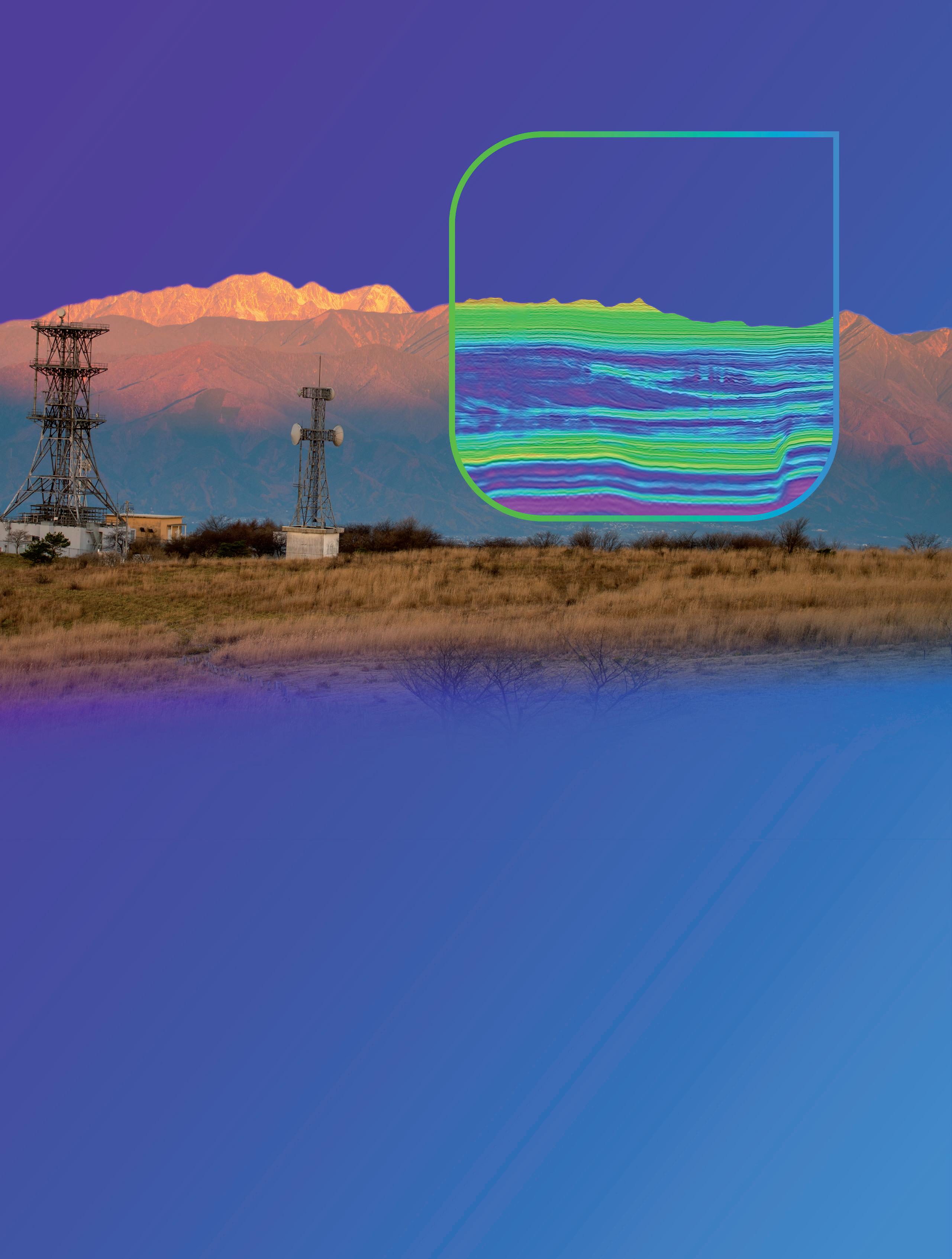
cgg.com/earthdata OUR
FROM
PERSPECTIVE. SE E THINGS DI FF ERE NT LY
PLANET.
A NEW
CHAIR EDITORIAL BOARD
Gwenola Michaud (Gwenola.Michaud@cognite.com)
EDITOR Damian Arnold (editorfb@eage.org)
MEMBERS, EDITORIAL BOARD
• Paul Binns, consultant (pebinns@btinternet.com)
• Lodve Berre, Norwegian University of Science and Technology (lodve.berre@ntnu.no) Satinder Chopra, SamiGeo (satinder.chopra@samigeo.com)
• Anthony Day, PGS (anthony.day@pgs.com)
• Peter Dromgoole, Retired Geophysicist (peterdromgoole@gmail.com)
• Rutger Gras, Consultant (r.gras@gridadvice.nl)
• Hamidreza Hamdi, University of Calgary (hhamdi@ucalgary.ca)
• John Reynolds, Reynolds International (jmr@reynolds-international.co.uk) James Rickett, Schlumberger (jrickett@slb.com) Peter Rowbotham, Apache (Peter.Rowbotham@apachecorp.com)
• Dave Stewart, Dave Stewart Geoconsulting Ltd (djstewart.dave@gmail.com)
• Femke Vossepoel, Delft University of Technology (f.c.vossepoel@tudelft.nl)
• Angelika-Maria Wulff, Consultant (gp.awulff@gmail.com)
EAGE EDITOR EMERITUS
Andrew McBarnet (andrew@andrewmcbarnet.com)
MEDIA PRODUCTION
Saskia Nota (firstbreakproduction@eage.org)
PRODUCTION ASSISTANT
Ivana Geurts (firstbreakproduction@eage.org)
ADVERTISING INQUIRIES
corporaterelations@eage.org
EAGE EUROPE OFFICE
Kosterijland 48 3981 AJ Bunnik
The Netherlands
• +31 88 995 5055
• eage@eage.org
• www.eage.org
EAGE MIDDLE EAST OFFICE
EAGE Middle East FZ-LLC
Dubai Knowledge Village Block 13 Office F-25 PO Box 501711
Dubai, United Arab Emirates +971 4 369 3897
• middle_east@eage.org www.eage.org
EAGE ASIA PACIFIC OFFICE
UOA Centre Office Suite 19-15-3A No. 19, Jalan Pinang 50450 Kuala Lumpur Malaysia
• +60 3 272 201 40
• asiapacific@eage.org
• www.eage.org
EAGE AMERICAS SAS
Calle 93 # 18-28 Oficina 704 Bogota, Colombia
• +57 1 4232948
• americas@eage.org
• www.eage.org
EAGE MEMBERS CHANGE OF ADDRESS NOTIFICATION
Send to: EAGE Membership Dept at EAGE Office (address above)
FIRST BREAK ON THE WEB www.firstbreak.org
ISSN 0263-5046 (print) / ISSN 1365-2397 (online)
47
On the development and application of airborne GPR solutions
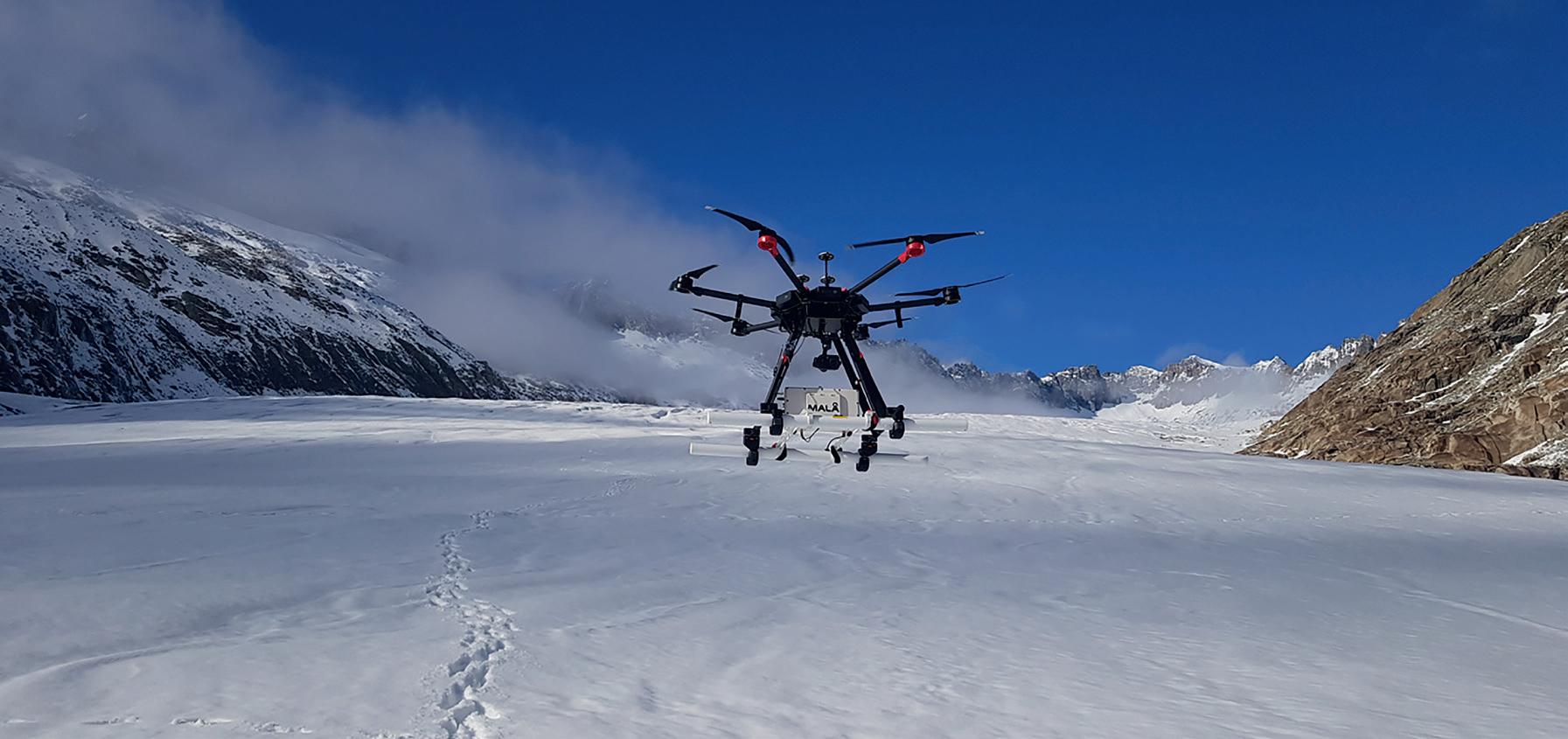
Editorial
3 EAGE News
Personal Record Interview
Monthly Update
Crosstalk
Industry News Sp ecial Topic: Near Surface Geo & Mining 37 Semi-airborne electromagnetic exploration using a scalar magnetometer suspended below a multicopter Michael Becken, Philipp O. Kotowski, Jörg Schmalzl, Gregory Symons and Klaus Brauch 47 On the development and application of airborne GPR solutions Jesper Emilsson, Johan Friborg, Jaana Gustafsson, Jimmy Adcock and Andreas Viberg 55 Active and passive-source underground seismic data acquisition T.-J. Hupe, D. Draganov, and D. Orlowsky 61 Aggregate (sand and gravel) exploration with 2D electrical resistivity imaging and test drilling on the western limits of the Balcones Fault Zone in Texas, US Hector R. Hinojosa 69 Advanced imaging techniques provide new near surface details in 3D seismic exploration data and an application to new energy-related offshore shallow subsurface investigations Julien Oukili, Terje Kultom Karlsen, Bertrand Caselitz, Jens Beenfeldt and Allan McKay 75 Finding blind ore bodies using 3D seismic: St Ives-Victory, Western Australia Kevin Jarvis, A. Foley, M. Falconer, G. Turner, J. Kinkela, R. Smith, S. Bright and S. Ziramov 79 Application of 3D optical fibre reflection seismic in challenging surface conditions
Sasha Ziramov, Andrej Bona, Konstantin Tertyshnikov, Roman Pevzner and Milovan Urosevic
91 Application of the magnetic geophysical method to exploration of the Potassic Zone in some Porphyry Copper Deposits (Iran) Shohreh Hassanpour, Mehmet Salih Bayraktutan and Snežana Komatina
98 Calendar
cover: Chuquicamata, open-pit copper mine, Calama, Chile.
FIRST BREAK I VOLUME 40 AUGUST 2022 1
Contents
17
18
20
23
FIRST BREAK ® An EAGE Publication
European Association of Geoscientists & Engineers
Board 2022-2023
Near Surface Geoscience Division
Esther Bloem Chair
Andreas Aspmo Pfaffhuber Vice-Chair


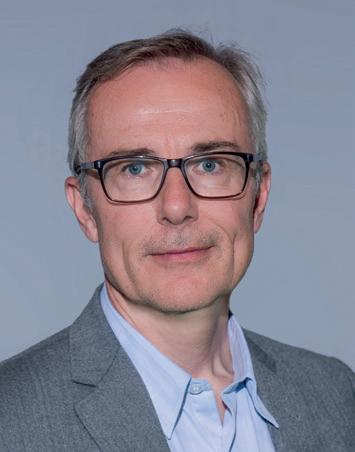

Alireza Malehmir Immediate Past Chair
Micki Allen Contact Officer EEGS/North America
Adam Booth Committee Member
Hongzhu Cai Liaison China
Eric Cauquil Liaison Shallow Marine Geophysics
Deyan Draganov Technical Programme Officer
Wolfram Gödde Liaison First Break
Hamdan Ali Hamdan Liaison Middle East

Vladimir Ignatev Liaison Russia / CIS
Musa Manzi Liaison Africa
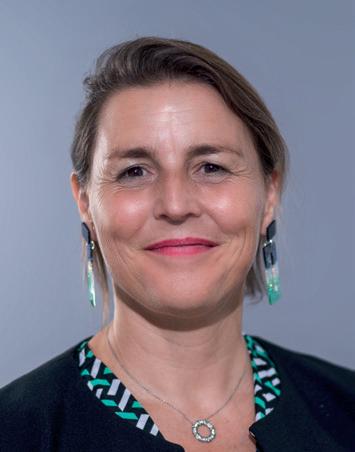
Myrto Papadopoulou Young Professional Liaison
Catherine Truffert Industry Liaison


Panagiotis Tsourlos Editor in Chief Near Surface Geophysics
Florina Tuluca Committee member
Oil & Gas Geoscience Division
Lucy Slater Chair
Yohaney Gomez Galarza Vice-Chair
Michael Peter Suess Immediate Past Chair; TPC
Erica Angerer Member
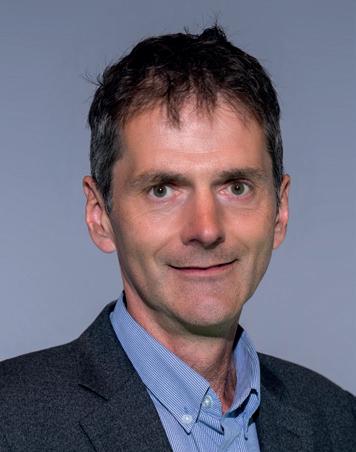
Wiebke Athmer Member
Juliane Heiland TPC
Tijmen Jan Moser Editor-in-Chief Geophysical Prospecting Francesco Perrone Member
Matteo Ravasi YP Liaison
Jonathan Redfern Editor-in-Chief Petroleum Geoscience
Giovanni Sosio DET SIC Liaison
Aart-Jan van Wijngaarden Technical Programme Officer
SUBSCRIPTIONS
First Break is published monthly. It is free to EAGE members. The membership fee of EAGE is € 80.00 a year including First Break, EarthDoc (EAGE’s geoscience database), Learning Geoscience (EAGE’s Education website) and online access to a scientific journal.
Companies can subscribe to First Break via an institutional subscription. Every subscription includes a monthly hard copy and online access to the full First Break archive for the requested number of online users.
Orders for current subscriptions and back issues should be sent to EAGE Publications BV, Journal Subscriptions, PO Box 59, 3990 DB, Houten, The Netherlands. Tel: +31 (0)88 9955055, E-mail: subscriptions@eage.org, www.firstbreak.org.
First Break is published by EAGE Publications BV, The Netherlands. However, responsibility for the opinions given and the statements made rests with the authors.
COPYRIGHT & PHOTOCOPYING © 2022 EAGE
All rights reserved. First Break or any part thereof may not be reproduced, stored in a retrieval system, or transcribed in any form or by any means, electronically or mechanically, including photocopying and recording, without the prior written permission of the publisher.
PAPER
The publisher’s policy is to use acid-free permanent paper (TCF), to the draft standard ISO/DIS/9706, made from sustainable forests using chlorine-free pulp (Nordic-Swan standard).
2 FIRST BREAK I VOLUME 40 I AUGUST 2022
Caroline Le Turdu Membership and Cooperation Officer
Peter Rowbotham Publications Officer
Pascal Breton Secretary-Treasurer
Aart-Jan van Wijngaarden Technical Programme Officer
Esther Bloem Chair Near Surface Geoscience Division
Lucy Slater Chair Oil & Gas Geoscience Division
Edward Wiarda Vice-President
Jean-Marc Rodriguez President
Maren Kleemeyer Education Officer
How EAGE can meet the need to change
Incoming EAGE president Jean-Marc Rodriguez (recently vice president exploration, Asia Pacific, TotalEnergies) has a clear vision of how to address the challenges ahead for EAGE.
A first self-imposed challenge for our 2022-23 president of EAGE Jean-Marc Rodriguez is wrestling with how to bring the Association’s mission statement up to date. ‘It needs to change,’ he says, ‘Energy transition and clean energy including oil and gas are now priorities. It is also what young members want to be part of.’
Modernizing the mission statement to keep geoscience and engineering relevant is indicative of Rodriguez’s recognition that EAGE needs to continue to evolve.
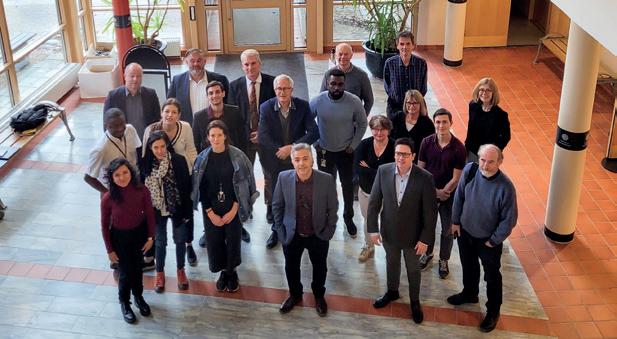
In his view, it is ahead of its peer societies in responding to the changing professional landscape. That said, the future focus of the Association, how it operates and meeting members expectations pose some chal lenging questions for Rodriguez, his Board colleagues and the executive management.
He identifies some basic trends start ing with the undeniable shrinking of the traditional base of geoscience and engi neering professionals. ‘At the current rate we are going to face a serious shortage of talent in five years time. We know that oil and gas activity will be around for decades to come, yet the next generation is shying away from involvement. Of course we cannot change the world, but we have to provide an attractive vision of the profession with education and train ing support, for example, liaising more closely with the academic world. It is up to us to promote the need to develop clean
technology solutions and the employment opportunities this presents.’
Rodriguez points to the emerging importance of critical subsurface resources such as mined minerals and metals in deliv ering decarbonisation through technologies such as wind turbines and batteries for electrification. He is also convinced that the increasing need to share knowledge and data across geographical borders, between industries and among all subsurface stake holders will lead to jobs, investment and economic growth.

On the horizon Rodriquez believes that, of the many possibilities out there, green hydrogen may prove to be one of most significant technologies, i.e. produc ing hydrogen processed with the output of emission-free solar, wind or hydro power.
Of most direct significance for our professional community will be the ongo ing development of carbon capture and storage. ‘This is familiar territory for any one who has been involved in oil and gas exploration and production. It promises a long-term activity. In the first place there is the technology for identifying potential locations. Once a project has started, then it has to be kept going, basically for ever. That means regular repeat geophysical surveys to ensure the safety of the site and thus a steady flow of employment.’
In the short term, probably the key issue for EAGE is how to manage its
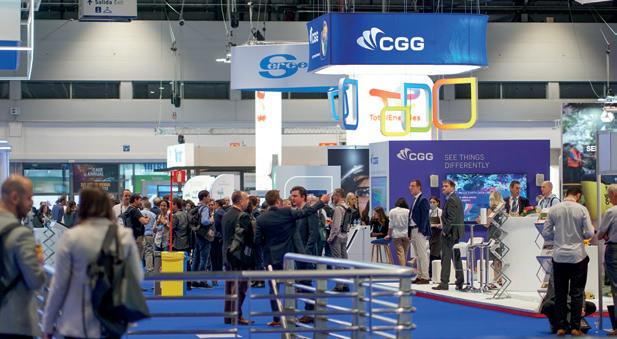
events and education programmes to meet members’ expectations. ‘It has become obvious that there are too many events worldwide being offered in our sector,’ Rodriguez says. ‘We see meetings held by different societies overlapping and, frankly, sometimes recycling the same papers with a little bit of updating. Among other things, this affects attendance and the viability of these gatherings. In fact organisations have begun to question the value proposition, putting a limit on both in-person and online participation by their staff.’
The priority, says Rodriguez, is to offer quality events. ‘EAGE’s strategy is to basically build the schedule around our key proven and emerging events, adding others by exception when the demand is clear.’
Especially when it comes to serving members in the regions such as Southeast Asia, the Middle East, Latin America and Africa where members and support services are spread thinner, he believes that there is a good case for cooperation with sister societies. ‘Collaboration makes sense avoiding unnecessary duplication of topics and all the effort and resources which go into organizing an event. This need not dilute the EAGE and our core mission. But having spent much of my time in the US, I think I understand the differences and believe we can do better on the cooperation front with our sister US societies.’
FIRST BREAK I VOLUME 40 AUGUST 2022 3
EAGE Annual in pictures 06
HIGHLIGHTS
NSG2022 heads for Belgrade 10 Uppsala students up for debate 15
Madrid proved a great return for the EAGE Annual

It was an amazing week in beautiful, sunny Madrid for the 83rd EAGE Annual Conference and Exhibition. The convergence of science, technology, policy and ambition was the focus of many discussions throughout the programme of the EAGE Annual 2022 demonstrating how geoscientists and engineers contribute to solving the world’s greatest resource challenges.
hydrocarbon exploration are changing and where the evolving role of the exploration function will inevitably lead.
Opening Session
‘Leading Geosciences in a New Era’ was the theme of the event, introduced at the Opening Session by a brief video drawing attention to the new competencies and practices that will make geoscientists and engineers more competitive in access ing the opportunities that the future will provide.
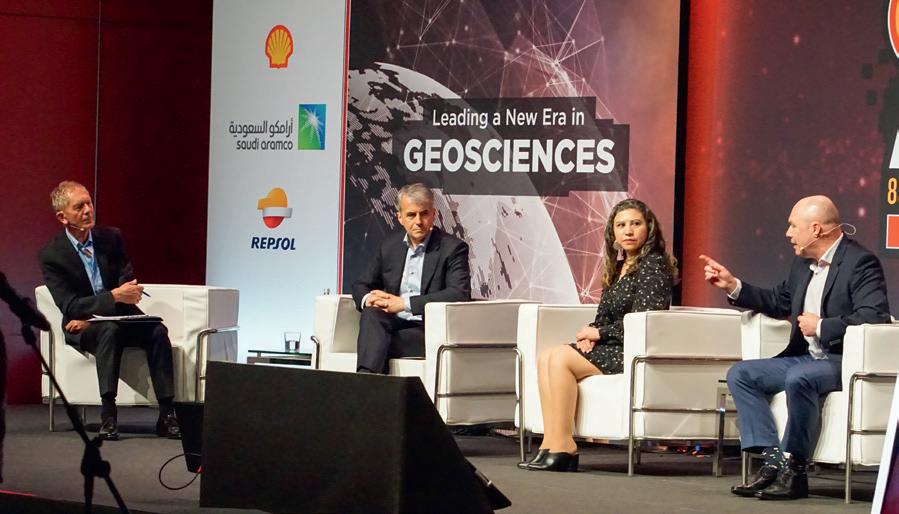
We began with the official welcome from EAGE president Dirk Orlowsky. A new feature of the Opening Session this year was the live ‘fireside chat’ between Josu Jon Imaz (CEO, Repsol) and Andrew McBarnet (EAGE Editor Emeritus). Imaz emphasised that demonising the oil indus try was not helpful in addressing energy transition and that his company was play ing a leading role in affecting change.
This was followed by the Awards Ceremony highlighting outstanding tech nical papers together with professional achievements and contributions to the geoscience community.
The afternoon was completed by the first of four plenary forums entitled ‘How Energy Transition Will Unfold: The Big Picture’ in which Imaz (Repsol) was joined by Leanne Todd (S&P Global Commodi ty Insights) and Simon Flowers (Wood Mackenzie). The panellists highlighted the increasing pressure and challenges that the energy resource industries are facing and the need to reframe the energy
transition process (See First Break July 2022, p.19 for a report on this discussion and Crosstalk for commentary).
Technical Programme
The Technical Programme this year included more than 800 presentations, over 124 sessions covering the spectrum of EAGE’s multi-disciplinary community such as digitalisation, sustainability, geo thermal energy, imaging, full wave inver sion, seismic acquisition and processing, mineral exploration, etc. Complementing the Technical Programme were 12 work shops with over 130 presentations.
The conference domes were once again implemented in the Exhibition Hall and continued to prove their success in being able to bring Technical Programme partic ipants and the exhibitors closer together.
Plenary Forums
Other major features of the EAGE Annual 2022 included the insightful discussions between international energy industry leaders and analysts held as plenary forums each day between technical ses sions. Tuesday’s forum entitled ‘Adapting O&G Exploration to the New Energy Era’ featured a stellar line up of Marc Gerrits (Shell), Irene Basili (Shearwater), Michael Wynne (S&P Global Commodity Insights) and Joseba Murillas (Repsol) highlighting how the geography and technology of
Wednesday’s forum ‘Advancing Sub surface Low Carbon Solutions’ tackled the challenges in decarbonisation of the world’s energy and industrial activities. Ariel Flores (BP), Mikel Erquiaga (Rep sol), Ann Robertson-Tait (GeothermEx) and Claude Bordenave (TotalEnergies) outlined where current research and investment are focused. They also empha sized the skill sets likely to be required for the upcoming generation of professionals.
The forum series ended on Thurs day with a discussion on ‘Why Minerals Matter for the Geoscience Community’. Minerals and metals are in increasing demand to make energy transition a real ity. Our panellists - Campbell McCuaig (BHP Resource Centre of Excellence), Torgeir Stordal (Norwegian Petroleum Directorate), Adriana Citlali Ramírez (TGS) and Paul Lusty (British Geological
Survey) - discussed the developments of mineral exploration and production, together with the fresh opportunities that may be opening up for our geoscience and engineering professions.
Exhibition Networking at the conference was as usual a key ingredient. At this year’s Annual we welcomed 150 exhibitors and
EAGE NEWS 4 FIRST BREAK I VOLUME 40 I AUGUST 2022
Repsol CEO Josu Jon Imaz talks with EAGE Editor Emeritus Andrew McBarnet during the Opening Session.
Panel session on future of minerals and mining.
had around 70 dedicated talks on market developments and services.
We were delighted to introduce a brand-new Energy Transition Area in the Exhibition of our Annual Meeting in Madrid this year. The area was filled with companies working in the energy transition sector and beyond, and included a theatre programme where we could take a look at the energy transmission and distribution networks worldwide and identify how to create a fully integrated energy system to deliver affordable zero carbon energy.
Meanwhile, the now established Digital Transformation Area continued to explore and showcase forward-thinking technology and workflows. The highlights in this area were two panel discussions on ‘Challeng ing Decision for O&G Data Management Departments’ and ‘The Future of Comput ing in the Energy Industry’.
Field Trips
Three one-day geological field trips near Madrid city were held during the EAGE Annual 2022: 1) a site visit to the under ground natural gas storage at Yela (Guada lajara), including stops at outcrops of the gas storage reservoir and top seal rocks analogues; 2) a discovery of geothermal potential of the Madrid Basin, visiting outcrops of the Madrid Basin basement and the Mesozoic/Cenozoic sedimentary infill; and 3) a visit to Molina-Alto Tajo Global UNESCO Geopark (Guadalajara), an outstanding geological heritage with a remarkable geodiversity.
Community and student activities Being the focal point of the EAGE’s non-technical activities, the Communi ty Hub was buzzing during the week. Through our network of communities and local chapters, we explored inter-disci plinary connections in geosciences and exchanged experiences in a series of talks. The session hosted by our Young Professionals Community explored how organisations – from large internation al energy companies to start-ups and universities – adapted to the new era of remote-office work and education.
We exceeded our expectaions
Reflecting on the week, Marcel van Loon, EAGE chief executive, said: ‘Madrid definitely exceeded our expectations. It was great to welcome nearly 5000 participants in person and online. People clear ly wanted to reconnect, but equal ly important for us is that they appreciate that EAGE is offering a programme and strategy relevant to the needs of the geoscience and engineering professional commu nity. We now look forward to seeing you all again next year in Vienna, 5-8 June.’
The Women in Geoscience and Engineer ing session on ‘Navigating Career and Life in a New Era’ was an interactive discussion about finding your place in the rapidly changing world and setting your own meaningful path in a career and life at large. With the opportunity of hosting the event in the Spanish capital, our Local Chapter Madrid had the pleasure of intro ducing delegates to some of the hidden gems of the city.
Our Career Advice Centre continued its mission to assist delegates in their personal development and career outlook through interactive sessions such as men toring, LinkedIn training, CV advice and professional portrait photography.
Students attending the Annual also found dedicated activities to navigate the next steps of their academic path. After two years being held online, this year’s Laurie
Dake Challenge final round was brought back to in-person at the EAGE Annual 2022. Five best teams presented their final development plans to an expert jury. Let’s cheer the team of University of Miskolc (Hungary) for winning the challenge!
This year two Geo-Quizzes were organised, one for the student delegates attending the conference in-person and one for those attending online. Congrat ulations to the winners: Adrián González Gallego (MIERES), Mahdi Bakhtbidar (University of Barcelona) and Anthony Yorillo (EOST) for in-person participa tion; Raha Hafizi (University of Barce lona), Parth Patadiya (Pandit Deendayal Energy University) and Ismailalwali Babikir (Universiti Teknologi PETRO NAS) for online participation.
We also brought together local stu dents in Spain and student chapter rep resentatives to meet and talk about their experience and offer them opportunities for social interaction with their peers.
Social programme
Finally, no Annual would be completed without a Conference Evening! This year our Conference Evening was held at Pala cio del Negralejo and it was sensational. Colleagues got together, enjoyed a wide selection of Spanish traditional foods (from jamón, paella and tortilla de patatas to arroz con leche), saved the good vibes at our photo booth and danced the night away.
For the success of the conference, thanks are due to everyone who helped make it possible: our reviewers, chairper sons, sponsors, exhibitors, and of course, all presenters and attendees.



EAGE NEWS FIRST BREAK I VOLUME 40 AUGUST 2022 5
FOR THE FULL STORY IN PICTURES, SEE FOLLOWING PAGES
Conference Evening on a beautiful night in Madrid.
EAGE chief executive Marcel van Loon with president Dirk Orlowsky.



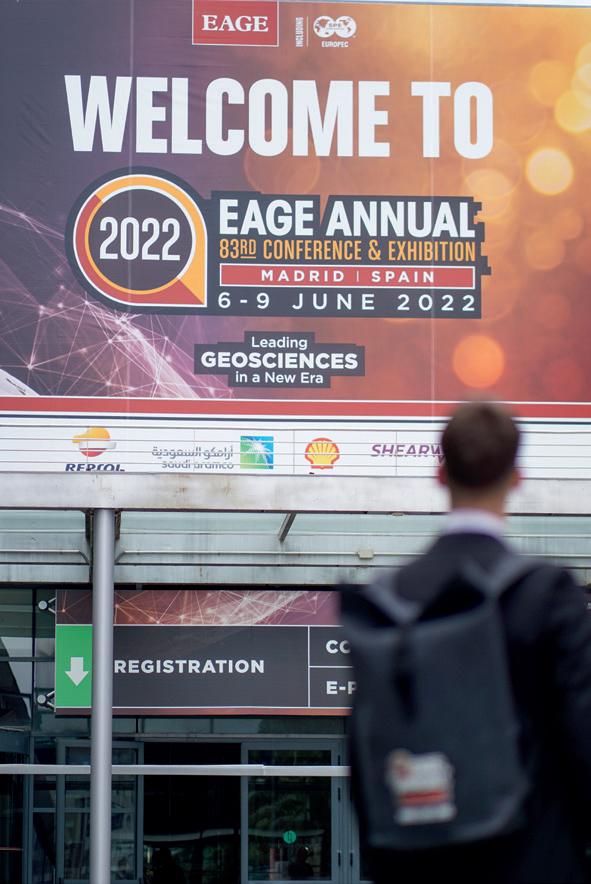
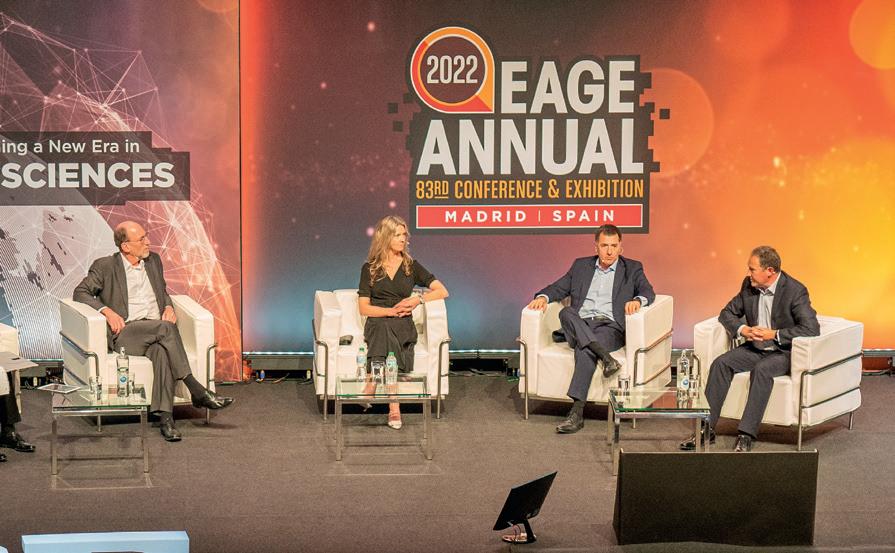




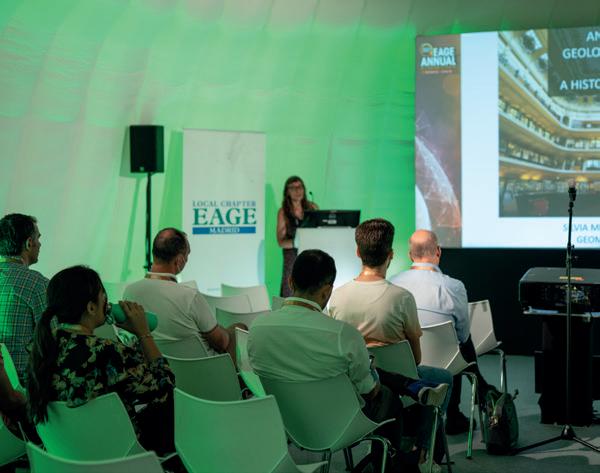

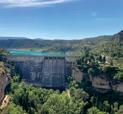



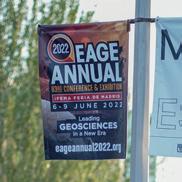
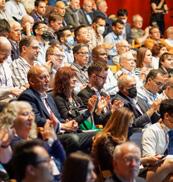
ANNUALWELCOME HIGH LEVEL SPEAKERS REVELATION MOMENTS SPECIAL SESSIONS EAGE ANNUAL - MADRID 2022
EAGE
We can’t thank you enough for joining us at the EAGE Annual 2022. Take a look back at some great moments captured in Madrid and see how the event looked like in numbers here.









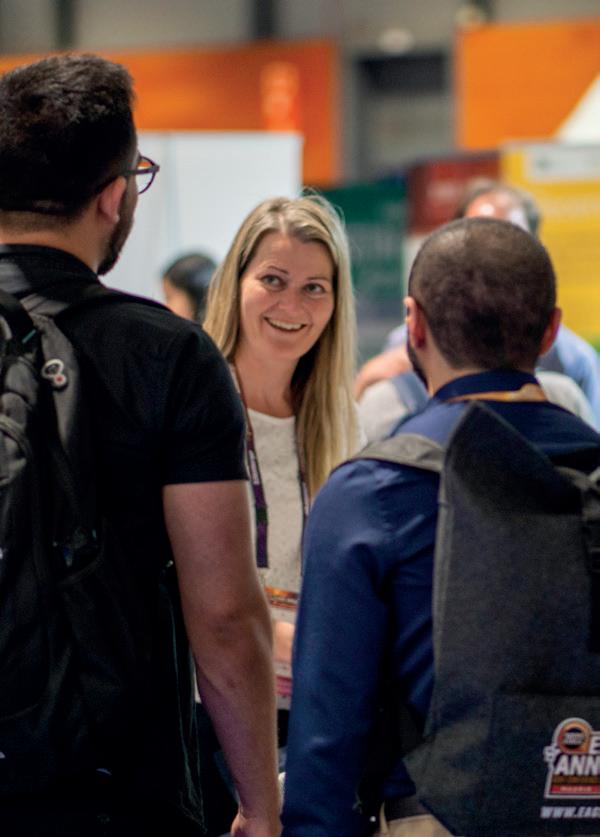
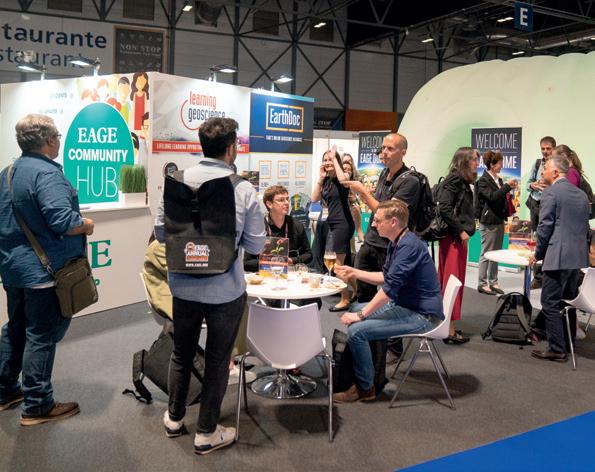
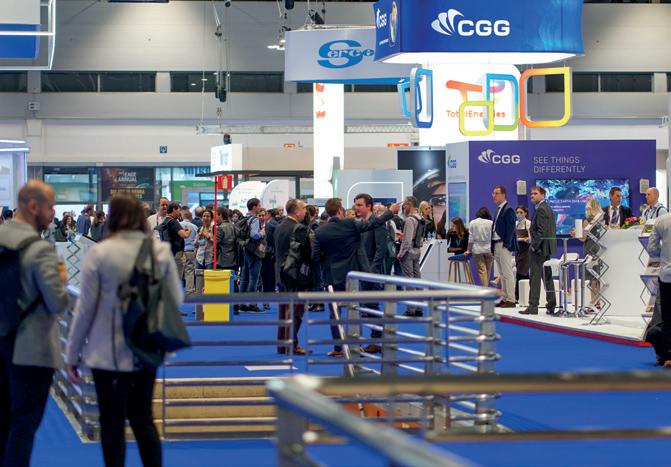


-
MADRID 2022
LIVELY EXHIBITION PARTY TIME NETWORKING EVERYWHERE
EAGE in co-launch of new journal for the transition era
Officially announced in June at EAGE Annual, Geoenergy is a new co-owned journal of EAGE and the Geological Society of London to be launched in January 2023. In tandem with its sister journal, Petroleum Geoscience, it will focus on the publication of timely and topical research in subsurface geosci ence and the emerging energy transition field.
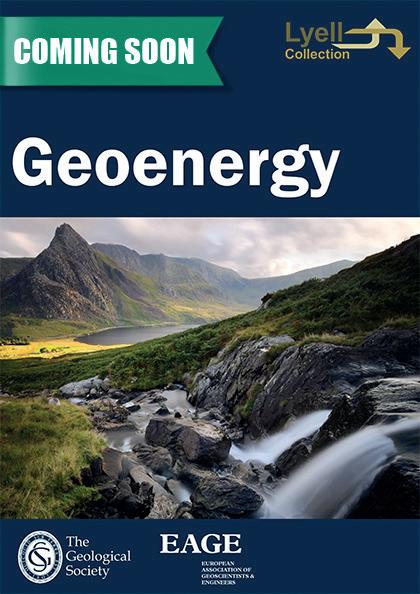
Welcoming the initiative, EAGE publications officer Peter Rowbotham said: ‘With EAGE’s priority to be mem ber-centric, Geoenergy provides a home for those members wishing to publish their latest research and case studies in sustainable energies. By continuing to support the Petroleum Geoscience journal, both EAGE and the Geological Society of London acknowledge that energy transition encompasses both oil and gas as well as old and new non-fossil fuel energy topics.’
Key themes of Geoenergy are expect ed to include energy storage, geothermal energy, subsurface disposal and storage, hydrogen energy, critical minerals and sustainability.
Rob Strachan, Geological Society Publications Secretary, said: ‘The Geolog ical Society is delighted to be developing its collaboration with EAGE, and building on the success and reputation of Petrole um Geoscience, to launch Geoenergy, a timely and relevant new journal covering energy geoscience. The geosciences have a key role in the development of sustain able energies and the energy transition, and we expect Geoenergy to become a leading outlet for publication of key work in this area by an international geoscience community. The launch of the journal aligns with the Society’s Energy Transi tion scientific theme launched in 2019 and broader work in serving the community in this space.’
Jonathan Redfern (University of Man chester) will be the journal’s first Editor-inChief. Working in tandem with Geoenergy and Petroleum Geoscience, he will have the task of ensuring that Petroleum Geo science continues to publish a balanced mix of traditional hydrocarbon-related and applied subsurface geoscience research, still highly relevant to today’s society. The increasing submissions of non-petroleum related subsurface geoscience, critical for this new era of sustainable energy, will be published in Geoenergy.
Find out more at https://www.geolsoc. org.uk/geoenergy.
ADDITIONS THIS MONTH
The Third EAGE Marine Acquisition Workshop will take place in Oslo (Norway), on 22-24 August. Proceedings will include approximately 13 abstracts and will become available on EarthDoc around two weeks before the event.
Full papers of the European Conference on Mathematics of Geological Reservoirs (ECMOR 20220), to be held in The Hague (Netherlands), on 5-7 September 2022, will also be hosted on EarthDoc.
25-30 extended abstracts from the Second EAGE Workshop on Advanced Seismic Solutions in the Gulf of Mexico (7-8 September 2022, Mexico City) will enable the sharing of knowledge on seismic acquisition, data processing and imaging, and the role of seismic interpretation and shallow structure
New issues of Petroleum Goescience and Near Surface Geophysic s will be accessible on EarthDoc in August.
Lastly, all EAGE book titles are now available in the Epub format on EarthDoc. For reading Epub there are all kinds of e-readers available. Find more information at https://www.earthdoc.org/content/books. Active EAGE members can use MyEAGE credentials to order books and benefit from a 15% member discount. You do not need to be an EAGE member in order to access EarthDoc and purchase books.
EAGE NEWS 8 FIRST BREAK I VOLUME 40 I AUGUST 2022
FWI VELOCITY











SIMULTANEOUS MODEL-BUILDING AND LEAST-SQUARES IMAGING
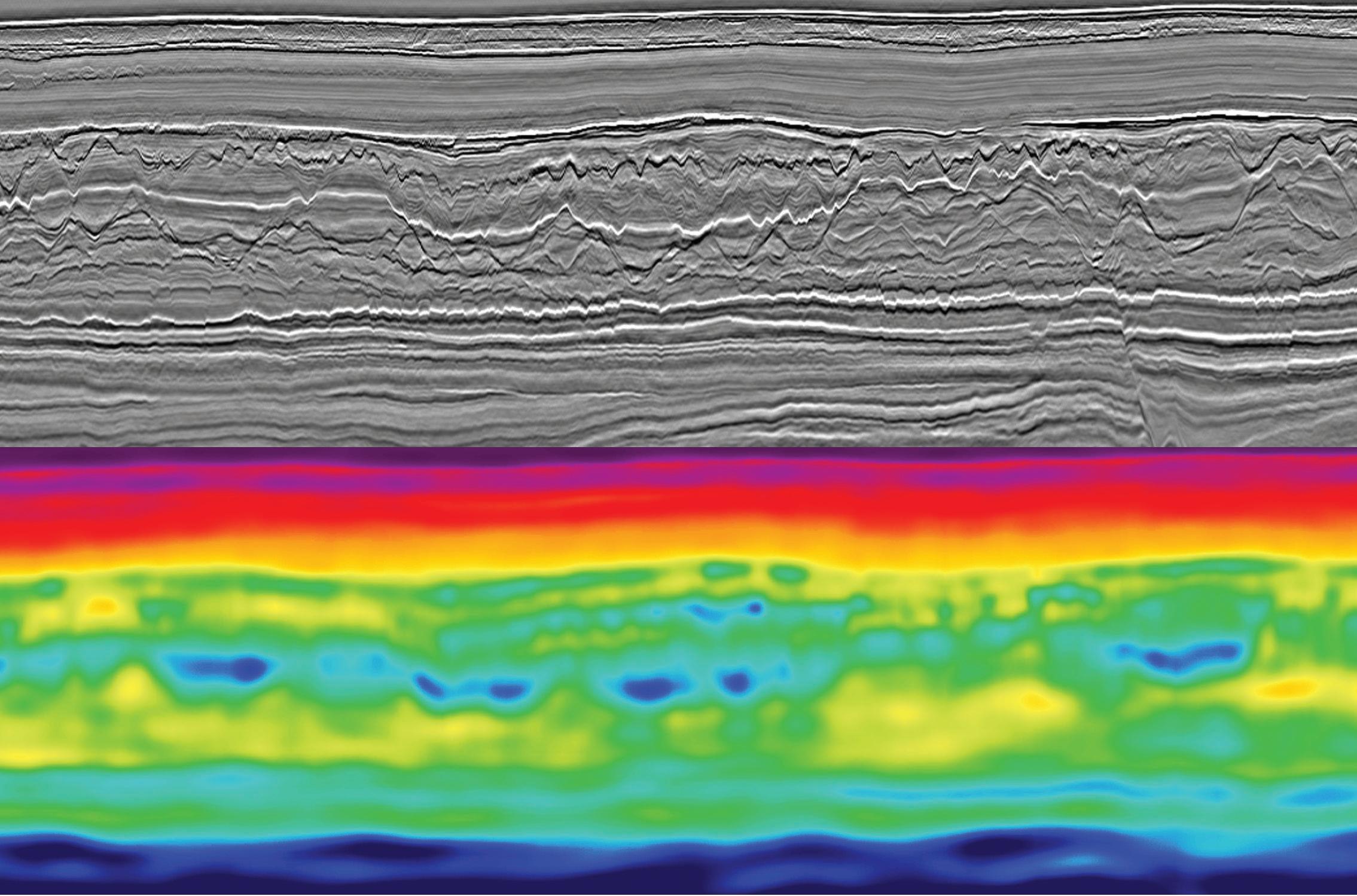
There’s no need to pull a rabbit out of a hat when it comes to reflection FWI. DUG’s unique augmented acoustic wave equation isolates the “roo ears” for high-resolution velocity updates beyond the diving-wave limit. It also enables least-squares imaging using the entire wavefield providing high-frequency reflectivity volumes for quantitative interpretation. Simultaneous velocity model building and least-squares imaging directly from field data.

85 Hz FWI IMAGE
BEX MC3D data courtesy of Multi-Client Resources
For more information contact us at info@dug.com
A roo-volution in seismic imaging!
seismic
Near-surface community heading for memorable Belgrade event
The waiting is nearly over. We are closing in on this year’s Near Surface Geoscience Conference & Exhibition (NSG2022) which is being held for the first time in Belgrade on 18-22 September.

The landmark event consists of three parallel meetings – the 28th European Meeting of Environmental and Engineer ing Geophysics, the 4th Conference on Geophysics for Mineral Exploration and Mining and the 3rd Conference on Air borne, Drone and Robotic Geophysics – with compelling workshops, dedicated talks on EU Affairs, a special programme for student and young professional dele gates and a leading-edge exhibition.
The scientific committees have worked on creating a comprehensive technical programme with a wide range of presentations and engaging discus sions. There will be a special session on ‘Applied Geophysics Case Studies from the Balkans’ and a joint session on ‘Airborne EM for Mineral & Mining’. The technical programme will be com plemented by the EU Affairs programme focusing on EU funding projects tack ling near-surface studies. The schedule and more information is available on our website.
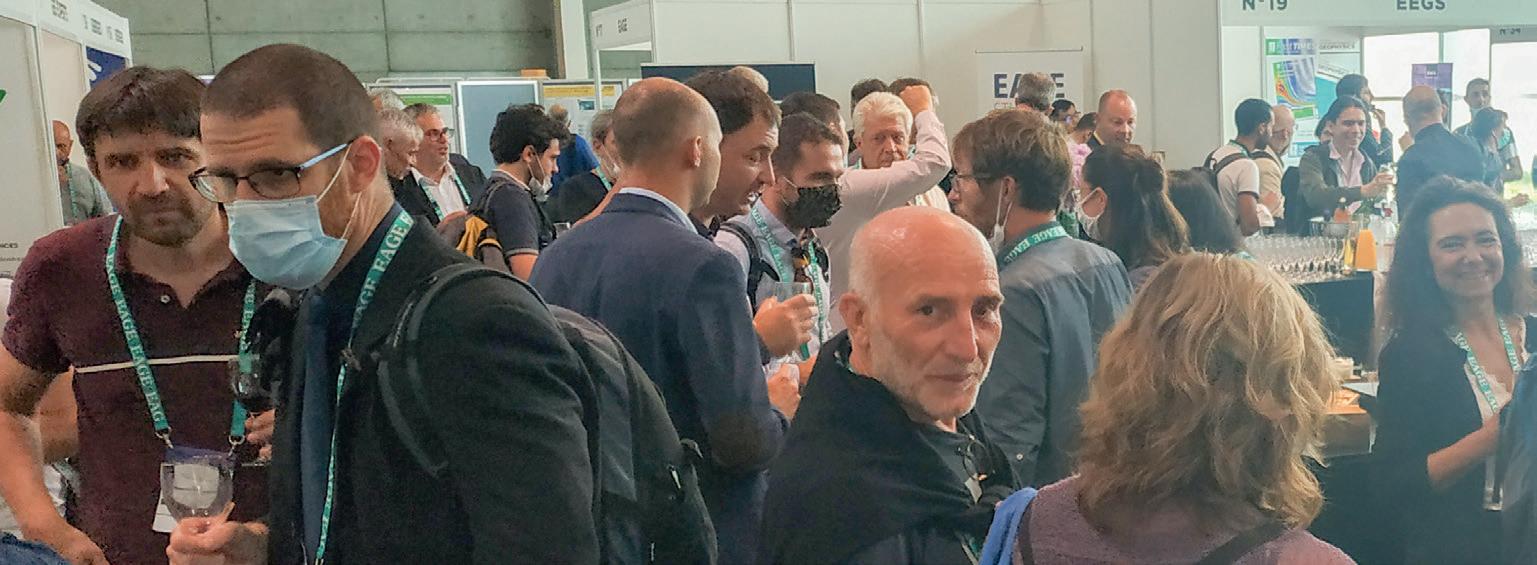
The ever-popular exhibition will once again welcome international com panies from the near-surface industry to showcase their newest technologies and services, including demonstrations.
Students and young profession als attending NSG2022 will have an opportunity to meet representatives from companies in the exhibition to learn more about career possibilities, as well as to take part in career boosting activ ities including speed mentoring and CV check.
You can top up your week by par ticipating in one of our four workshops. The workshop on ‘2D and 3D Seismic Data Processing Focused on the Near Surface’ will cover processing of several types of near-surface seismic data. The workshop on ‘Geotechnical Applications
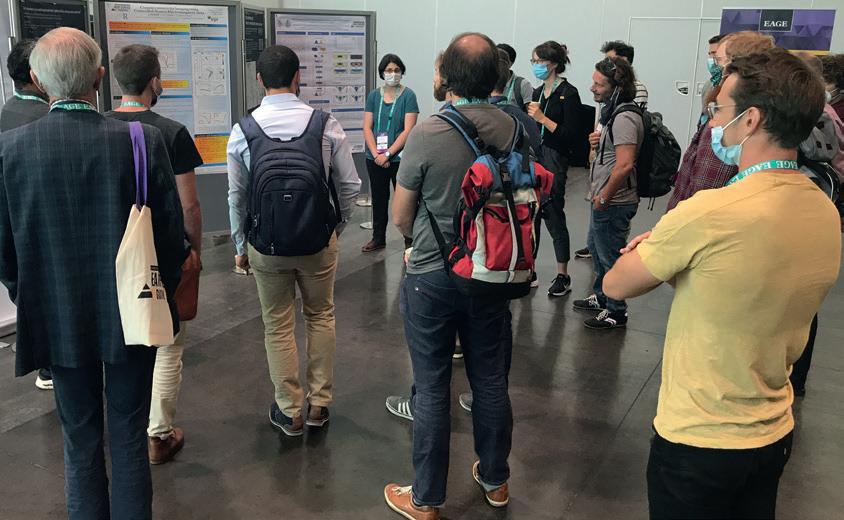
of Geosciences’ aims to bridge the gap between geosciences and ground/geo technical engineering, intended for both geoscientists and engineers. Meanwhile, the other two workshops entitled ‘Pro cessing, Inversion and Visualisation of Towed TEM Data for Aquifer Mapping’ and ‘From AEM Data to 3D Hydroge ological Conceptual Model’, are both related to software and equipment for near-surface uses and will combine short lectures with hands-on exercises.
Belgrade, our host city is especially relevant to the near-surface professional community. It is an urban gem of Eastern Europe lying on the confluence of the Sava and Danube rivers. The Balkans and especially Serbia are facing familiar issues and societal challenges - from access to critical raw materials for the energy transition, climate action strategy to environmental issues such as geohaz ards, water accessibility for agriculture, and archaeology.
There are so many good reasons to join us in Belgrade and find out how the near-surface geosciences have advanced, meet your peers and experience the diverse activities NSG2022 will offer you. Save on your attendance at this very special EAGE event by registering before 22 August at www.NSG2022.org.
EAGE NEWS 10 FIRST BREAK I VOLUME 40 I AUGUST 2022
Busy session at 2021 Near Surface meeting.
Poster session in progress.
All important networking occasion.
Eighteenth ECMOR returns as an in-person meeting in The Hague

EAGE’s three-day European Conference on the Mathematics of Geological Res ervoirs (ECMOR) will once again be an in person event when it arrives in The Hague on 5-7 September (with some online elements). Our last on-site meeting was in Barcelona in 2018.
ECMOR, being held for the 18th time, is a key conference for applied mathema ticians, engineers, and geoscientists from academia, governmental bodies and indus try working on subsurface energy system modeling. Its technical programme this year has much to offer for those who are interested in topics such as physical mod elling, computational methods and uncer tainty modelling and optimisation. The Technical Committee received more than 110 abstracts acceptable for presentation in all categories from 25 countries world wide. Application domains are extended from hydrocarbon recovery towards new requirements on carbon capture storage, H2 storage and geothermal energy. This time several contributions highlight the potential opportunities in the fields of digitalisation, artificial intelligence and automation for increasing the efficiency and productivity of subsurface energy systems.
The programme will consist of 18 oral sessions, divided over three days and two parallel sessions. Participants attending on-site will benefit from the full experi ence of the conference, which will also address challenges related to the energy transition, promote open debates during technical sessions and foster exchang es between participants in an informal atmosphere.
The venue chose for this year’s meet ing is The Hague Conference Centre, New Babylon. Situated right next to the central
train station, it is only a couple of minutes walk to the city centre. As with previous on-site ECMOR events, participants can also expect a unique networking reception experience accompanied by two poster sessions on the first evening of the confer ence. The ECMOR committee is looking forward to welcoming participants to The Hague and re-connecting once again with this specialist community. For more infor mation on the Technical Programme and details on how to register, please visit www.ecmor.org.
Milan to host sixth HPC workshop
tional ways of interpreting seismic and reservoir data.
This is why the sixth edition of the successful EAGE High Performance Computing workshop presents such a great opportunity. It is due to take place at the Rosa Grand Hotel, Milan, Italy from the 19-21 September 2022.
(HPE), Michael Sprague (National Wind Technology Centre) and Victor Martin (TotalEnergies).

High Performance Computing (HPC) plays a leading role in our current energy business and will be of critical importance for a successful energy tran sition. The explosion of data and the recent rapid development in machine learning (ML) are leading to non-tradi
Main topics to be covered include Geoscience & HPC, Performance Anal ysis and Optimisation, Emerging HPC Technologies and HPC for the Energy Transition. Keynote speakers on this dramatically changing climate within the industry include Luca Bertelli (ENI), Daniela Galetti (CINECA), Maxim Alt
The workshop will also provide par ticipants a chance to visit the Green Data Centre in Ferrera Erbognone. This is home to HPC4 and its upgraded HPC5, one of the most powerful and efficient supercomputers in the world.
You can now review the technical programme on the website for the event, made possible thanks to the support from Platinum sponsors Eni, Hewlett Packard Enterprise and AMD. The workshop begins with an IceBreaker Reception hosted by Shell.
EAGE NEWS FIRST BREAK I VOLUME 40 AUGUST 2022 11
Eni Green Data Centre, Italy.
Majestic buildings of The Hague.
Petroleum Geoscience (PG) transcends disciplinary bound aries and publishes a balanced mix of articles that drives the science to enhance sustainable development covering all aspects of the petroleum system. The journal content reflects the international nature of the research. A new edition (Volume 28, Issue 3) will be published in August, featuring 8 articles.
Editor’s Choice articles:
• Petrographic and diagenetic investigation of the distal Triassic ‘Budleighensis’ fluvial system in the Solway and Carlisle Basins for potential CO2 storage
– Joshua R. Marsh et al.
• Comparison of shale depth functions in contrasting offshore basins and sealing behaviour for CH4 and CO2 containment systems – Oscar J. Nhabanga and Philip S. Ringrose
Near Surface Geophysics (NSG) publishes primary research on the science of geophysics as it applies to the exploration, evaluation and extraction of earth resources. Drawing heav ily on contributions from researchers in the oil and mineral exploration industries, the journal has a very practical slant. A new edition (Volume 20, Issue 4) will be published within August, featuring 7 articles.
Editor’s Choice articles:

• Near-surface three-dimensional multicomponent source and receiver S-wave survey in the Tannwald Basin, Germany: Acquisition and data processing – Thomas Burschil et al
• Marine karst environment characterization using joint geophysical and geotechnical data – Judith Dusart et al.
EAGE Annual bags donated to The Gambia
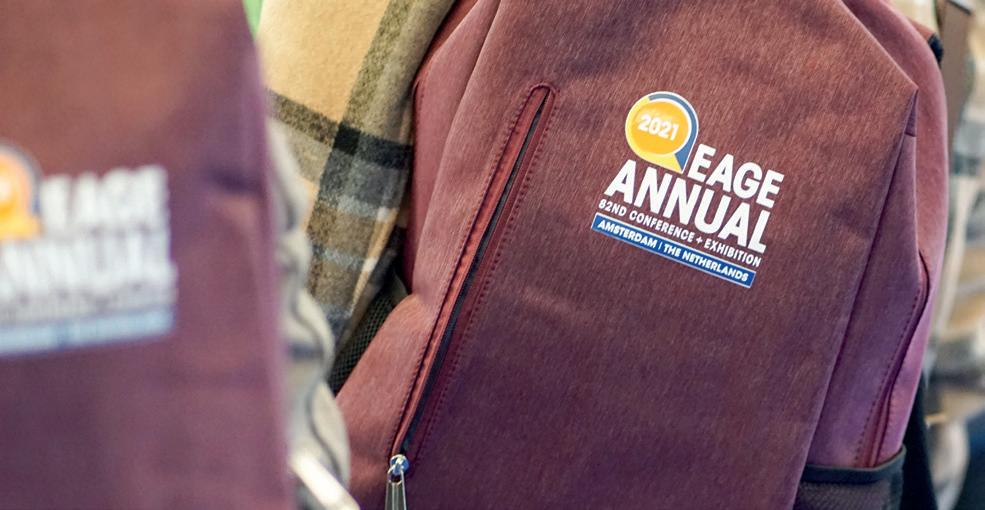
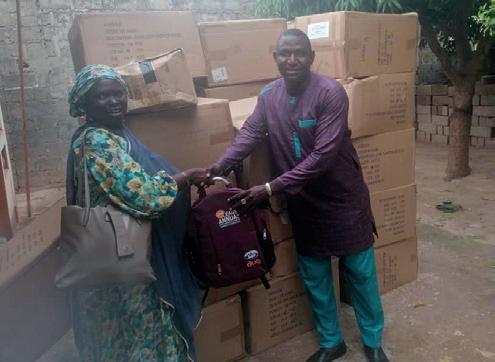
As part of our corporate social responsibility, EAGE is committed to recycling our event materials and supporting good causes. After the 82nd EAGE Annual in Amsterdam in October 2021, EAGE was approached by the Buganala Foundation regarding any unclaimed delegate bags left over after the event that could possibly be donated to charity. The Buganala Foundation aims to make a positive contribution to the lives of children and young adults in The Gambia, West Africa, their families and other people in their living environment, through education and relevant activities.
The request prompted us to hunt down any remaining bags from previous EAGE events that had been stored in the Houten office. We eventually located a total of 1500 bags from a variety of events held in recent years.
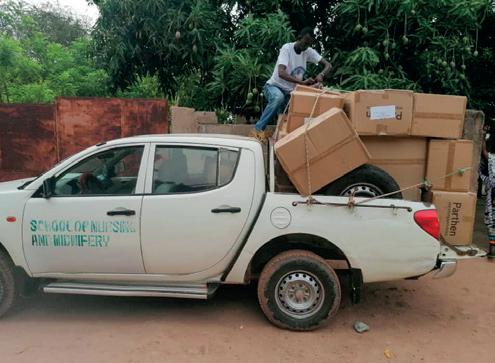
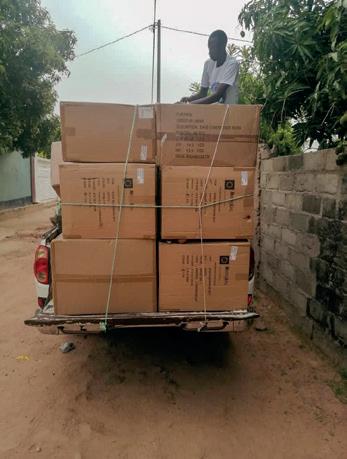
Some 100 bags were picked up by a representative of the Buganala Foundation from EAGE’s premises at the end of December 2021 and then the rest were shipped to The Gambia directly from the port of Rotterdam.
We are told that students in The Gambia have received the bags and use them daily to take their study belongings with them. Among the recipients were teachers and students from a school for the deaf and a teacher training institution.
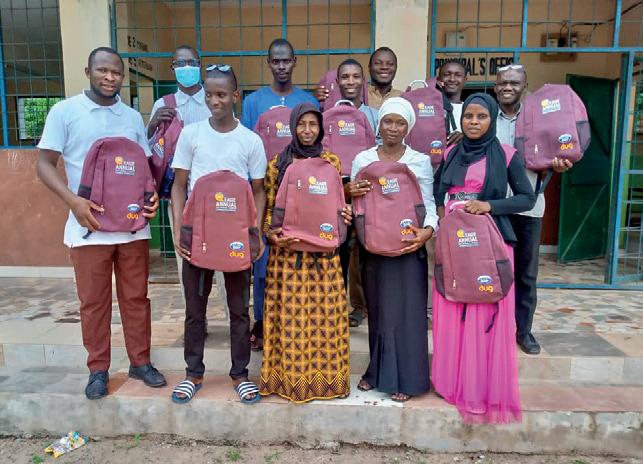
EAGE NEWS 12 FIRST BREAK I VOLUME 40 I AUGUST 2022
OUR
CHECK OUT THE LATEST JOURNALS PG NSG
JOURNALS THIS MONTH
The distinguished Czech geophysicist Prof Vlastislav Červený has died at the age of 90. His whole professional life was associated with the Depart ment of Geophysics of the Faculty of Mathematics and Physics of Charles University in Prague. He graduated in 1956, becoming associate pro fessor in 1966 and full professor in 1987.


During his career he became a world leading scientist in seismic ray theory and one of the most cited seismologists. He published three well-known books and numerous pub lications. He founded the consortium Seismic Waves in Complex 3-D Struc tures in 1993 and led it for over 25 years, attracting worldwide attention from both industry and academia. He was also a founder of the famous series of workshops ‘Seismic Waves in Laterally Inhomogeneous Media’, which proved an ideal platform for meetings of seismologists from the East and West during the Cold War era.
Professor Červený was an active member of several international insti tutions, member of the German Aca demia Leopoldina and the Academia Europaea, and an Honorary Member of the European Association of Geoscien tists and Engineers and the Society of Exploration Geophysicists. He received the Beno Gutenberg medal of the European Geophysical Society (now European Geosciences Union), the Maurice Ewing medal of the Society
of Exploration Geophysicists, the Ernst Mach medal of the Czech Academy of Sciences and the Gold Memorial medal of Charles University. His work will continue through his numerous students and colleagues who always enjoyed his generous and kind nature and benefited from his wisdom and great insight.
Prof Červený will be remembered as a great educator, who never hesitated to explain even the simplest facts down to the smallest detail. This is what made his book Seismic Ray Theory such an extremely well readable textbook. Those who had contact with him will treasure visits to his office at Ke Kar lovu and the tea or coffee prepared by his secretary Mrs Drahotová. He will be greatly missed.
Remembered by Petr Bulant, Leo Eis ner, Zuzana Jechumtálová, Petr Jílek, Luděk Klimeš, Tijmen Jan Moser, Ivan Pšenčík and many others all over the world who came into contact with Slava and his work.
EAGE NEWS FIRST BREAK I VOLUME 40 AUGUST 2022 13 EAGE Online Education Calendar FOR THE FULL CALENDAR, MORE INFORMATION AND REGISTRATION PLEASE VISIT WWW.EAGE.ORG AND WWW.LEARNINGGEOSCIENCE.ORG. * EXTENSIVE SELF PACED MATERIALS AND INTERACTIVE SESSIONS WITH THE INSTRUCTORS: CHECK SCHEDULE OF EACH COURSE FOR DATES AND TIMES OF LIVE SESSIONS START AT ANY TIME VELOCITIES, IMAGING, AND WAVEFORM INVERSION - THE EVOLUTION OF CHARACTERIZING THE EARTH’S SUBSURFACE, BY I.F. JONES (ONLINE EET) SELF PACED COURSE 6 CHAPTERS OF 1 HR GEOSTATISTICAL RESERVOIR MODELING, BY D. GRANA SELF PACED COURSE 8 CHAPTERS OF 1 HR CARBONATE RESERVOIR CHARACTERIZATION, BY L. GALLUCCIO SELF PACED COURSE 8 CHAPTERS OF 1 HR 2-5 AUG INTRODUCTION TO DATA ANALYSIS: CONCEPTS AND EXAMPLES, BY R. GODFREY IOSC 4 HOURS/DAY, 8 MODULES 9-12 AUG BOREHOLE SEISMIC FUNDAMENTALS AND INTRODUCTION TO ADVANCED TECHNIQUES, BY A. CAMPBELL IOSC 4 HOURS/DAY, 6 MODULES 23-26 AUG CONSTRUCTION OF FRACTURED RESERVOIR MODELS FOR FLOW SIMULATION INCORPORATING GEOLOGY, GEOPHYSICS AND GEOMECHANICS, BY REINALDO MICHELENA, CHRIS ZAHM & JAMES GILMAN IOSC 4 HOURS/DAY, 8 MODULES 24-26 AUG SUB-SURFACE UNCERTAINTY EVALUATION (SUE), BY MANISH AGARWAL
30 AUG
2 SEP
IOSC 4 HOURS/DAY, 6 MODULES 6-9 SEP
-
UPSCALING AND ARTIFICIAL INTELLIGENCE BASED PROXIES FOR UNCERTAINTY ASSESSMENT OF RESERVOIR PRODUCTION, BY DR DOMINIQUE GUERILLOT
IOSC
4 HOURS/DAY
INTEGRATED
SEISMIC ACQUISITION AND PROCESSING BY JACK BOUSKA IOSC
4 HOURS/DAY, 8 MODULES
Vlastislav C ˘ ervený 1932-2022
Etienne Robein 1949-2022
Former EAGE president Etienne Robein has died after a long illness.
Etienne graduated from Ecole Nationale Supérieure de l’Aéronau tique et de l’Espace in 1972, followed by the Ecole Nationale Supérieure du Pétrole et des Moteurs/IFP, where he trained as a geophysicist. He started his career with Shell in The Hague, before joining Elf, now TotalEnergies, where he worked on operational, research and managerial assignments in France, Italy, the UK and Azerbaijan.
Etienne authored or co-authored many presentations at international conferences, including those of EAGE, SEG, WPC and AAPG. His first text book Vitesses et Techniques d’Image rie en Sismique Réflexion; Principes et Méthodes was published, in French, in 1999. In 2003 he published the text book Velocities, Time-Imaging and Depth-Imaging in Reflection Seismics and in 2010, as part of his EAGE Education Tour, a textbook on Seismic Imaging. A Review of the Techniques, their Principles, Merits and Limitations. All these books have been best-sellers among tutors and students. In 2015 and 2016, he record ed two EAGE e-lectures as part of the Learning Geoscience prgramme, namely Reverse-Time Migration, How Does it Work and How to Use it? and On the Use of Epsilon and Delta in Anisotropic Velocity Model Building. To watch his lectures again is to understand the gift Etienne had to simplify topics that appeared com plicated. After retiring from Total,
Etienne continued his career as a successful instructor for international companies.

Etienne was president of EAGE in 2000 where, thanks to his strong worldwide network of geoscientists, he contributed to the international growth of EAGE and to the coor dination between EAGE and SEG activities. He was also chairman of EAGE’s Research Committee, mem ber of the EAGE Awards Committee and Europe’s representative on the SEG Council. In 2009, Etienne was made an EAGE Honorary Member.


During his international assign ments, like those at the Elf /Total Geo science Research Centre in the UK, Etienne loved mentoring his young international staff, many of them now pursuing very successful careers in the industry.
Etienne could not spend a day without some form of physical activity, the minimum being an hour running
or cycling before his working day. When he was posted abroad, the routine was the same, only the circuits were different, jogging in Hyde Park when in London or cycling to the office through the Trastevere when in Rome.
But his real passion was moun taineering. At regular intervals, with a group of friends, he pushed the limits during different expeditions, just miss ing the 8000 m mark in the Himalaya. He also explored a few other peaks around 6000 m in the Andes, Africa and Russia, or went ice-climbing in Scotland. When he was not climbing, he would do some ski touring or some mountain biking in the Alps or the Pyrenees.
Etienne loved classical music, and when in a big city, he would never miss an opportunity to attend an opera or a good concert with his wife or with some friends. Thanks to his good ear, he became totally fluent in Italian and enjoyed entertaining his friends by picking different accents.
Etienne was one of those opinion leaders who did not need to raise their voice to be listened to. His natural authority came from his great level of geophysical expertise, but also his capacity to listen and to adopt new ideas, especially when they came from another discipline.
Our thoughts are with his wife Francine, who often joined Etienne at EAGE events.
EAGE NEWS 18-22 SEP NEAR SURFACE GEOSCIENCE CONFERENCE & EXHIBITION 2022 BELGRADE, SERBIA 7 OCT MINUS CO2 FINAL ONLINE 13 OCT STUDENT WEBINAR TAKING YOUR RESEARCH ONLINE WITH AN OPEN RESEARCH WEBSITE BY STEVES PURVES ONLINE EAGE Student Calendar FOR MORE INFORMATION AND REGISTRATION PLEASE CHECK THE STUDENT SECTION AT WWW.EAGE.ORG
Contributed by Olivier Dubrule and Philippe Malzac.
Uppsala students debate energy transition and raw materials
The EAGE Board members in town for a meeting were among the audience at the conference on energy transition and raw materials held on 3 May at Uppsala University, Sweden.
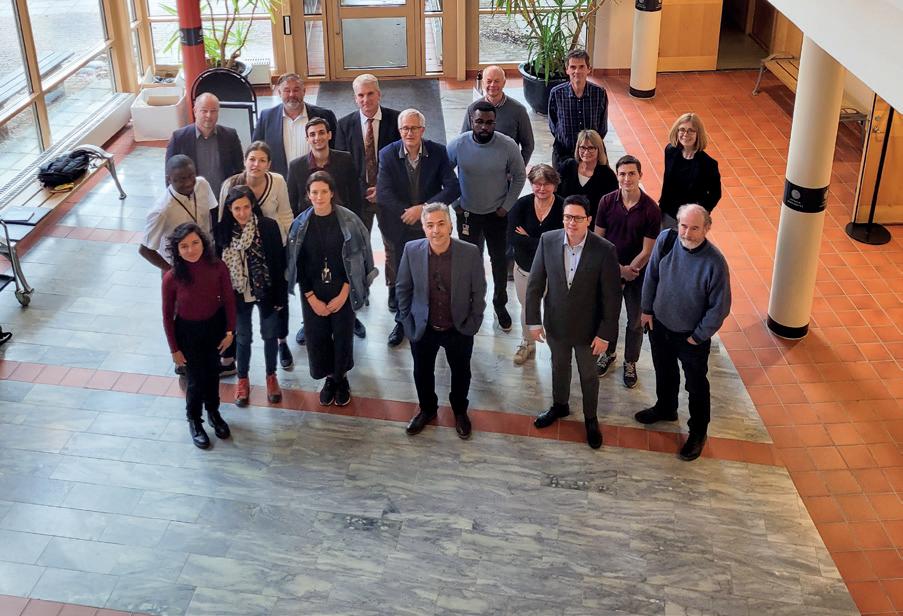
The conference was organised by young professionals from Uppsala Uni versity drawing attendance from different academic levels (bachelor to researchers) including top researchers and professors form Department of Earth Sciences and Chemistry Department of Uppsala Univer sity as well as from the Geological Survey of Sweden. Keynote talks were presented on various aspects of the energy transition, starting with EAGE’s strategy supporting
relevant initiatives and continuing with ongoing research projects within Uppsala University and Geological Survey of Swe den tackling this topic.
The conference included two sessions carried out by young professionals present ng a wide range of topics that support ener gy transition from different perspectives. Those presentations were developed in a ‘rapid-fire’ format consisting on nine slides each displayed for one minute according to a template provided by the organising com mittee. Around ten students from Uppsala University shared their research topics with the audience on subjects related to raw materials exploration, ground water mod elling, solutions for environmental batteries and so on.
Both keynote and young profession al speakers found this space fruitful to brainstorm ideas and make connections at different academic levels.
As a part of the programme, a formal discussion took place on energy transition and raw materials worldwide. The debate was moderated by the president of EAGE’s Uppsala University Student Chapter. Her main role was to manage the different viewpoints from a selected group of experts
integrating senior and junior professionals in energy transition. Those taking part were the EAGE vice-president, two professors from Department of Earth Sciences, a researcher from Geological Survey of Swe den and a PhD student from Department of Earth Science, Uppsala University.
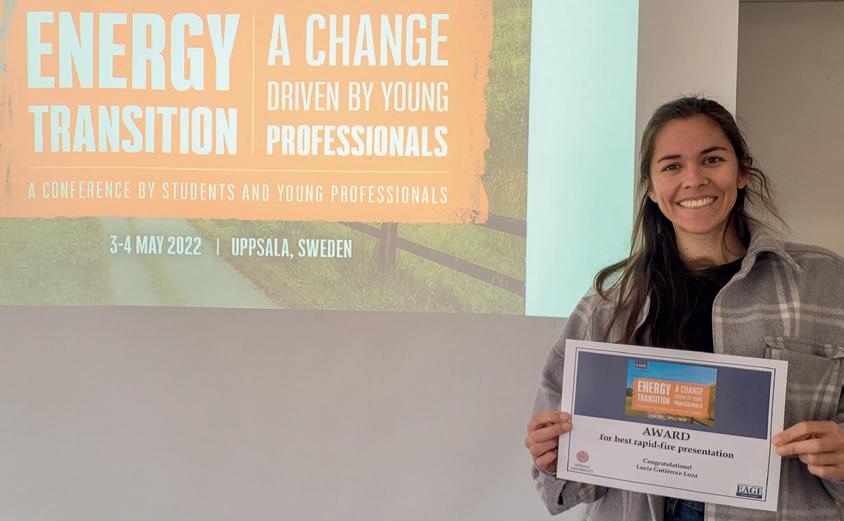
At the end of the conference, an award was presented to PhD student Lucia Gutiér rez for the best ‘rapid fire’ presentation ‘The ocean as a carbon sink or source. What controls the air-sea CO2 exchange?’ She received a diploma and travel grant to the EAGE Annual Meeting in Madrid presented by EAGE chief executive officer Marcel Van Loon.

Near surface and mineral exploration are the topics for Bogotá workshop
Bogotá, the vibrant and sprawling capital of Colombia, will host the Second EAGE Conference on Near Surface & Mineral Exploration in Latin America, on 3-4 November 2022.
For the first time, the event will be held in-person, offering a great chance to get acquainted first-hand with lat est developments and applications. The intention is to highlight geophysics for geothermal energy and energy transition, mining, geological, hydrogeological, geotechnical, environmental, engineer
ing, archaeological, and other applica tions, as well as physical soil and rock properties.
Sponsored by Iris Instruments, the conference welcomes industry experts, professionals, authorities, researchers, students, and companies, interested in joining a space to exchange ideas, best practices, and grow their network. Ben efit from the early registration fee until 23 September 2022. More details at: https://eage.eventsair.com/second-eageconference-on-near-surface-in-latin-america/
EAGE NEWS FIRST BREAK I VOLUME 40 AUGUST 2022 15
The EAGE Board among the audience at the conference on energy transition and raw materials at Uppsala.
Bogota will host this key event for Latin America.
Award to PhD student Lucia Gutierrez for the best rapid fire presentation.
Czech Local Chapter holds varied talks programme
Over the course of the past few months
LC Czech Republic organised four com munity meetings on topics ranging from caves to meteorites.
February saw Petr Tabořík (Insti tute of Rock Structure and Mechanics) discussing whether the Hranice Abyss, the deepest cave in the world, can real ly reach 1 km depth. It was a hybrid meeting with 25 online participants and 20 - mostly students - attending the presentation hosted at the Faculty of Natural Sciences. Numerous geophysical measurements, e.g., gravity, resistivity, gravity, seismic, etc., were discussed along with the constraints on the shape of the deep cave.
The March meeting consisted of a remote presentation by Dr Andrew Parsekian (University of Wyoming) on the changing Arctic climate entitled ‘The role of geophysics for measuring lakes in permafrost regions’. He provided some interesting insights into shallow geo physical methods and their limitations in the Arctic environment. Once again
the event was in collaboration with the Faculty of Natural Sciences, Seismik hosted Prof Gunther Kle tetschka (Faculty of Natural Sciences, Charles University) in April. He talked about infrequent yet present geophysical evidence for airbursts of meteorites in the earth atmosphere like the Tunguska (Russia) airburst. He showed evidence for similar blasts destroying Tall el Ham mam in Jordan and Abu Hureira in Syria, with the former being a candidate for bib lical Sodoma and Gomora destruction.
In May, Brij Singh (Institute of Geo physics of the Polish Academy of Scienc es) provided a second talk on seismic imaging in the hard rock environment. The audience included members of Local Chapters Germany and Poland leading to an interesting discussion.
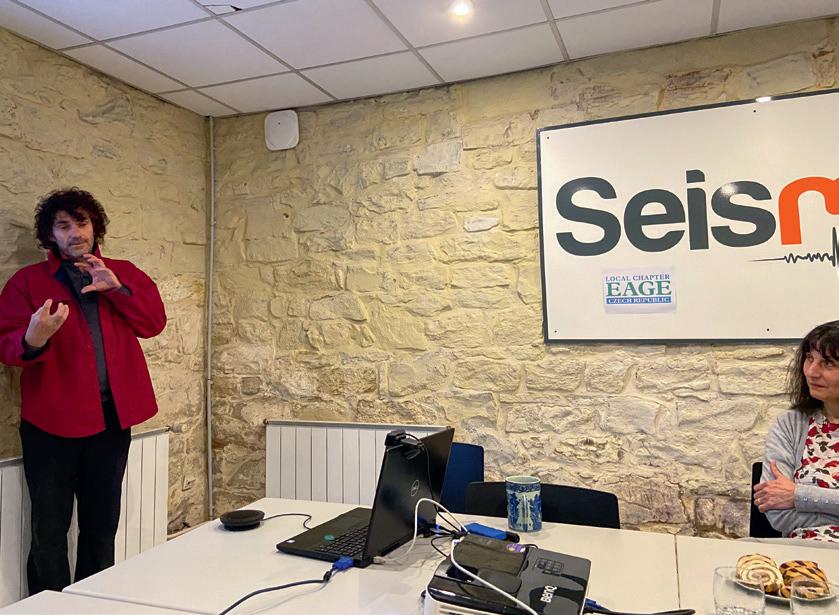
LC Czech Republic was also recently involved in the co-organised workshop APSLIM II on active and passive seismics in laterally inho mogeneous media and IWSA 19, the International workshop on seismic anisotropy.

Some 20 participants met at the Želiv Premonstratensian Monastery, Czech Republic from May 30 to June 3 to enjoyed a great technical programme in a peaceful atmosphere.
Students can keep an eye out for the 11th Student Prize which the Local Chapter will support for the third year in collaboration with Seismik s.r.o. and G-Impuls Praha s.r.o. Visit https:// www.seismik.cz/index.php/careers/seis mik-prize for more information about this and applications.
The EAGE Student Fund supports student activities that help students bridge the gap between university and professional environments. This is only possible with the support from the EAGE community. If you want to support the next generation of geoscientists and engineers, go to donate.eagestudentfund.org or simply scan the QR code. Many thanks for your donation in advance!
EAGE NEWS 16 FIRST BREAK I VOLUME 40 I AUGUST 2022
DONATE TODAY!
Participants of the workshop APSLIM II and IWSA 19 organized by EAGE Local Chapter Czech Republic.
Presentation at the EAGE Local Chapter Czech Republic spring event.
Personal Record Interview
What happened when airline career
Career didn’t start with geoscience?
No, I first worked with the British Over seas Airways Corporation (BOAC), the forerunner of British Airways (BA).
What made you change course?
It just wasn’t for me. I came across geology in a library and it connected with climb ing. So I left BOAC to study ‘A’ Levels, working intermittently as a road sweeper. The KPIs were set for age 50!, so I could do my stint quickly then study. I had some good advice when starting at Aberdeen University – ‘do two years of Maths’.

BGS and Sea of Hebrides research?
Brilliant job – an unmapped marine area around the well-known geology of the islands. Robert Eden and Gordon Craig, my bosses at BGS and Edinburgh Univer sity, arranged for me to submit the work for a PhD supervised by Bryan Lovell. Apart from shipborne surveys, we dived in the Hebrides and around Rockall – the only time I’ve used a hammer professionally is under water; the rest was seismic. We also dived in a submersible, including a traverse up the Hebridean slope from 381 m.
How did you come to join Shell?
The nature of the survey work changed. We were visited by Ken Glennie and Miles Bowen, and Shell Research advertised for a seismic stratigrapher. I found myself as the ‘geological conscience’ in the Geo physics Department. The Aberdeen maths enabled me to survive five years. This was
at the beginnings of quantitative interpre tation and a great learning experience.
What was special about Oman?
In the early 1980s there was a demand for exploration and the Oman Government was hugely encouraging. I was asked to test QI on the Oman carbonates. Working with Paul de Groot, David Mithen, Nic van Ooyen and others we made a series of successful predictions and seven discov eries. It was a stimulating environment. Life outside the office was good too, with walks in the Oman mountains. I have always been a regular runner and was able to continue this with ‘The Hash’ and Muscat Road Runners, though it took some acclimatisation.
Ups and downs in The Hague?
The ‘down’ was the first three years. The ‘up’ was the next four on the Middle East Africa Desk. Initially as the regional geolo gist then the area engineer jobs for Nigeria and Oman were added – a really interesting mix of business and science in several countries. It included acquisition of the Nigeria deepwater acreage, which was to generate the Bonga development and sever al other overseas commercial agreements. I also acquired a Dutch pilot’s licence.
What did you do in Nigeria?
I was exploration manager in SPDC’s Eastern Division. I wouldn’t have missed this for anything, but there were some very difficult times and situations. It was not easy for my wife Ceri, who was not able to continue teaching. At first funding
was restricted; under the government of the time exploration was to be axed. However, we survived. Fidel Onichabor’s prospect Santa Barbara South found 100 million barrels and, together with the seis mic industry, we increased field reserves.
How was Egyptian experience?
We had a very good department but again a budget-constrained situation – the oil price was $10/bbl. We had the deepwater block in which Eni made the 2015 Zohr discovery. We recognised the play but there were less risky first prospects than a 4 kilometre deepwater well.
Tell us about retirement?
We returned to the village we left 27 years earlier. A typical day is work, gardening and a run. Shortly after arriving back Arie Speksnijder asked me to help in the Shell Learning Centre. Together we set up an online course and I did this until recently – so 47 years doing something with Shell. Pat Corbett suggested teaching at Heriot Watt. I much enjoyed this and it lasted until now. After meeting Qing Sun, I wrote reports for C&C Reservoirs. So, a portfolio of interesting projects. I continued to fly and did a geology associateship with the Royal Photographic Society. I’ve been on the Board of the Scottish Energy Forum and its predecessor for some years and have just stepped down as an associate editor for First Break. Now I’m contracted to write a book and am finding out just how many hours this takes. I told someone it was ‘popular geoscience’ to which the response was ‘That’s a really good oxymoron’.
PERSONAL RECORD INTERVIEW
Paul Binns is proof positive that a career change to geoscience can be rewarding. He spent 27 years with Shell, including stints as exploration manager in Nigeria and Egypt, preceded by the British Geological Society (BGS) researching the unmapped Sea of Hebrides. Still busy consulting and teaching, he also has a book in progress.
didn’t cut it
FIRST BREAK I VOLUME 40 AUGUST 2022 17
PAUL BINNS







FIRST BREAK I VOLUME 40 I AUGUST 2022 18 The new Impact Factors have been released! Check out our journals’ scores here: Make sure you’re in the know EAGE MONTHLY UPDATE Second EAGE Workshop on Advanced Seismic Solutions in the Gulf of Mexico 4 August 2022: Regular Registration Fourth HGS/EAGE Conference on Latin America 12 August 2022: Regular Registration Near Surface Geoscience Conference & Exhibition 2022 22 August 2022: Regular Registration Sixth International Conference on Fault and Top Seals 31 August 2022: Regular Registration EAGE Conference on Digital Innovation for a Sustainable Future 15 August 2022: Early Registration ECMOR 2022 31 August 2022: Regular Registration 3rd EAGE Global Energy Transition Conference & Exhibition (GET 2022) 15 September 2022: Early Registration 31 October 2022: Regular Registration Second EAGE Workshop on East Canada Offshore Exploration 7 October 2022: Regular Registration Third EAGE Conference on Pre Salt Reservoir 1 September 2022: Early Registration 23 October 2022: Regular Registration Fourth EAGE Workshop on Unconventional Resources 15 October 2022: Early Registration 15 November 2022: Regular Registration 15 August 2022 3rd EAGE Global Energy Transition Conference & Exhibition (GET 2022) 15 August 2022 Fourth EAGE Workshop on Unconventional Resources 14 September 2022 Second EAGE Workshop on East Canada Offshore Exploration CALL FOR ABSTRACTS DEADLINES 2022 REGISTRATION DEADLINES 2022 5-7 SEPTEMBER 2022 I THE HAGUE, THE NETHERLANDS & ONLINE REGISTER NOW! POWERED BY


CROSSTALK
BY ANDREW M c BARNET
Dividing up the spoils and more
‘Another one bites the dust’ is the irresistible refrain of the 1980 chart-topping song by Queen. It rather sums up the unfortunate sale of ION Geophysical assets in a month that also saw TGS’s surprising move into the seabed seismic operational space. In the light of such significant market disruption, the imponderable questions are what’s next? and indeed who’s next?
But first, a nod to the fateful story of ION Geophysical. A brutal obituary might conclude that it acquired a string of quality assets but failed to convert them into the persuasive integrated offering to the oil industry that successive managements had aimed for. Lack of capital and the fickle seismic services market were undoubtedly contributing factors. Two or three years ago Chris Usher, who in 2019 took over as CEO, was belatedly pushing the ‘One ION’ idea.
Founded in 1968 as Input/Output (changed to ION Geophysical in 2007), it became a public company in 1991 as the unquestioned leading land seismic equipment supplier with its System One acquisition system. In 1995 marine products and vibrator trucks bought from Western Atlas were introduced plus in 1998 the DigiCourse range of streamer control and positioning devices. Around this time it also acquired two land seismic software companies Green Mountain Geophysics and Compuseis and, in 2001, the Pelton line of vibrator control accessories was added. However, the market downturn in 1999/2000 took its toll along with the impact of a declining but competitive land seismic technology market. The company was floundering when Bob Pee bler arrived in 2003 to inject new energy although never achieving the integrated solutions he envisaged during the several years he was heading the company. His landmark purchases were Concept Systems, a navigation and positioning software company, and seismic data processor GX Technology. During the Peebler era the company dabbled in truly innovative seabed seismic and cableless land seismic technology but ultimately came up short.

In 2010, ION divested its entire land seismic business to Inova Geophysical, a joint venture between BGP (51%) and
ION (49%), since 2019 fully owned by BGP. The deal included Aram Systems, a rival Canadian manufacturer that had been quite expensively acquired only two years previously.
ION’s 2022 bankruptcy effectively exposed how easily its main revenue sectors could be separated and sold off and just how valuable these might be in other hands. In the auction of the spoils, still to be ratified, CGG’s Sercel Sensing and Monitoring division looks to have a winner as successful bidder for ION’s software business. This presumably includes products developed by ION Concept Systems in Edinburgh including Orca, arguably the industry standard in towed-streamer command and control software used on 2D, 3D, high-resolution and multi-vessel seis mic programmes. The combination of Orca and the company’s own SeaPro navigation and positioning offerings will give Sercel a dominant position in the sector.
However, in line with CGG’s ‘Beyond the Core’ diversification strategy, ION’s Marlin software may be the real prize in terms of future potential devel opment. It is said to be the only commercially available marine management system that combines temporal project planning with 3D spatial situational awareness. It integrates AIS, GPS, GIS, MetOcean and visual data between onshore operations, offshore structures and other vessels to create a common operational picture of any given theatre of operations. MarlinPort has been particularly successful in offering better understanding of harbour ship activity from a safety, efficiency and environmental perspective.
Over its history ION built up a significant multi-client library. It had considerable success with its BasinSPAN mult-client surveys conducted in many prospective areas using a long offset and depth imaging to 40 km to provide a regional crustal-scale framework of PSTM and PSDM data for basin-scale geological studies, under standing petroleum 3D systems, and basin modelling. Fairfield Geotechnologies beat TGS to win the right to take ION’s US onshore multi-client datasets along with the offshore GulfSPAN and FloridaSPAN datasets. However, TGS is to pick up the rest of
20 FIRST BREAK I VOLUME 40 I AUGUST 2022
BUSINESS • PEOPLE •
TECHNOLOGY
‘Around the turn of the century the company lost its way.’
ION’s global offshore multi-client data library consisting of more than 637,000 km of 2D and over 317,000 km2 of 3D multi-client seismic data in major offshore petroleum provinces worldwide.
In addition, TGS is buying ION’s well-regarded data process ing capabilities built on its original GX Technology acquisition 15 or so years ago. This will enable TGS to significantly enhance the processing of its multi-client survey data, but also allow the com pany to market more aggressively its data processing capabilities.
The saying ‘luck is what happens when preparation meets opportunity’, usually attributed to the Stoic philosopher Seneca, seems to apply to TGS in buying the ION businesses. The company was perfectly positioned for this growth by acquisition.
However, the coincidental outright purchase announced in late June of seabed seismic contractor Magseis Fairfield marks a stunning change of course. Apart from one brief flirtation, TGS has for two decades steadfastly shunned the overhead and oper ational issues of owning seismic vessels and equipment. This enabled it to prosper like no other company in the sector by commissioning multi-client surveys, and in some years actually being the largest customer for marine seismic surveys.
Many say that TGS dodged the bullet in 2007 when its offer to buy marine seismic contractor Wavefield Inseis came to grief. At the time, this out of character move was widely interpreted as a bid to ensure vessel availability for its multi-client business during a boom period of intense competition between contractors. CGG eventually bought the assets a year later for a greatly reduced amount and was miserably rewarded by a major collapse in the market leaving the company’s fleet operations uncomfortably exposed.
TGS is right to insist that market conditions have changed so significantly since 2007-8 that comparisons with the Wavefield Inseis episode do not apply. For a start, this is a straight purchase unlike the Wavefield Inseis merger proposal. Even so, securing capacity looks like a key factor in the Magseis Fairfield deal. The demand for node-based seabed surveys has increased to the point that they comprise more than 30% and counting of all marine seismic surveys, and TGS wants to maximise its exposure. It has its eye particularly on opportunities offshore South America and West Africa. The company also believes that ocean bottom node (OBN) surveys offer a more stable market to ride the cycle because they are associated with meeting routine 4D monitoring requirements and low risk near field exploration. Further down the road it sees OBN playing a part in technologies such as off shore wind farms and carbon capture and storage, again offsetting the highs and lows of marine seismic demand.
What better solution than to own Magseis Fairfield, the largest operator in the business with a major track record in the US Gulf of Mexico and the North Sea, is how TGS seems to be thinking. It allows the company to plan and develop its future
seabed seismic multi-client surveys more thoroughly without the hassle of finding and negotiating an operator for the survey. There are cost benefits in this estimated at between $7 and $9 million a year. The strategy also fits with the company’s expectation of more ‘converted contracts’, meaning fewer potential clients providing higher prefunding but lower sales to cost.
But there is also a lot to be sceptical about. The seismic business has seen so many asset purchases transacted when market expectations are high only to see things fall apart at the first sign of a downturn. In the past TGS has been asset light and able to escape the burden of vessel and equipment ownership. Furthermore it has been able to invest in its multi-client library at lower cost when contractors have struggled to keep their vessels working.
Now that TGS is part of the OBN market as an operator and equipment supplier, everything changes. It will be in direct compe tition with existing survey operators and their technology offerings, not to mention any newcomers attracted by today’s optimistic market talk and the relatively low cost of entry compared, for example, with towed-streamer acquisition. Magseis Fairfield as the largest and most established player in the field seems to have little to fear in the short term from rivals such as Shearwater GeoServices, PXGeo, or PGS should it enter the fray. For the time being there seems to be enough work to go around and reportedly the demand for nodes could easily exceed supply by next year.
That said TGS has to commit resources to research and development to keep in the game, and who knows where that may lead and at what cost. Magseis Fairfield itself was born less than four years ago out of a defensive merger between two companies with very different cultures and OBN solutions. Whether all the integration challenges have been resolved is unclear, and the profitability of the merger is unproven.
TGS will surely have taken all the naysaying into account before making its move. OBN business will form only a minor part of the company’s overall business at a time when it is seeking to diversify in a number of directions.
Last month the company announced the acquisition of Predik tor, a Norwegian company supplying asset management and real-time data management solutions to renewable and energy asset owners around the world. Since 1995 the company is said to have carried out thousands of installations on industrial and energy assets enabling data-driven, automated operational solutions.
The Prediktor purchase provides an indication of the direction that TGS is taking with its New Energy Solutions initiative. The company is targeting opportunities opening up as the focus turns increasingly to energy transition. It is following closely develop ments in carbon storage, geothermal and deep-sea mining.
Meantime expect more consolidation moves in the seismic sector.
expressed in Crosstalk are solely those of the author, who can be contacted at andrew@andrewmcbarnet.com.
CROSSTALK FIRST BREAK I VOLUME 40 AUGUST 2022 21
‘Magseis Fairfield purchase marks a stunning change of course’
Views

TGS swoops to buy ION Geophysical’s multi-client business and Magseis Fairfield
TGS has announced a triple swoop of acquisitions: ION Geophysical’s mul ti-client and processing businesses, Mag seis Fairfield and the software provider Prediktor.
ION’s assets were auctioned after the company filed for Chapter 11 bankruptcy in the United States Bankruptcy Court for the Southern District of Texas.
2021. TGS said that it intends to employ a number of the ION employees associated with the acquired business.
TGS expects to close the transaction early in the third quarter.
Kristian Johansen, CEO of TGS, said: ‘We are now uniquely positioned in the traditional multi-client business, converted contracts, production seismic and 4D – all supported by a strengthened data processing business.’
TGS will fund the transaction from its current cash holding.

Meanwhile, TGS has agreed to buy Magseis Fairfield after putting forward a voluntary exchange offer to acquire all shares of Magseis in the form of 0.0426 ordinary shares of TGS and NOK 2.30 ($0.23) in cash per Magseis share. Based on the closing price of TGS on 28 June 2022, the value of the offer consideration is equal to NOK 8.6048 ($0.85) per Mag seis share, and the offer values the total issued share capital of Magseis at approxi mately NOK 2.333 billion ($231 million).
the Magseis shares of NOK 5.60 ($0.56) on 28 June 2022.
‘With a strengthening focus on costs and cycle times in the exploration and production of oil and gas, an increasing amount of demand of geophysical data is driven by infrastructure-led exploration (ILX) and production monitoring (4D seismic). Combining Magseis’s leading position in the ocean bottom node (OBN) market with TGS’s multi-client and data processing capabilities creates a unique offering of superior quality products and services across the value chain,’ said Johansen.

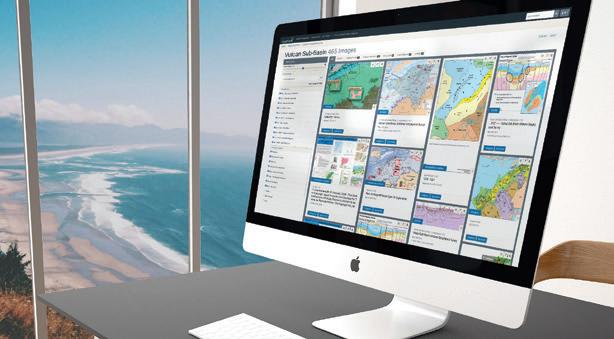
TGS will acquire all of ION’s global offshore multi-client data library and ION’s data processing and imaging capabili ties and intellectual property. ION’s data library consists of more than 637,000 km of 2D and more than 317,000 km2 of 3D multi-client seismic data in major offshore petroleum provinces globally. The revenues associated with the acquired assets were in excess of $86 million in
The board of directors of Magseis has unanimously recommended the offer. Magseis shareholders, including the larg est shareholder, Fairfield MS, LLC, and members of the Magseis Board and man agement, who collectively own 33.4% of the outstanding share capital of Magseis, have accepted the offer.
The offer represents a premium of 53.7% compared to the closing price of
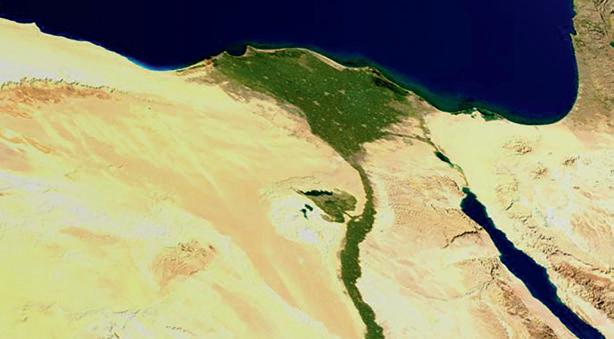
Carel Hooijkaas, CEO of Magseis, said: ‘The seismic industry is undergo ing a significant transformation brought about by fundamental structural chal lenges facing the industry. Adapting to these changes via consolidation will be beneficial to our investors and customers. The combined company will be a leading integrated seismic provider with a bestin-class OBN technology and track-re cord, strong data processing capabilities, and a multi-client business with a large customer base for the company’s oper ations and a truly global geographical footprint.’
Finally, TGS has acquired Prediktor, an asset management and real-time data management solutions provider. Predik tor’s software and systems are being utilized on: Benban (Egypt), the world’s
SLB shoots survey offshore Australia 28
CGG wins OBN contract in Nile Delta 31
HIGHLIGHTS INDUSTRY NEWS FIRST BREAK I VOLUME 40 AUGUST 2022 23
Searcher adds Indonesia to subsurface database 35
Kristian Johansen, CEO of TGS.
largest PV solar plant, built in 2019; Dogger Bank (UK), the world’s largest offshore wind farm, currently under construction; and Johan Sverdrup oil field (Norway), one of the world’s largest offshore oil and gas assets developed in recent times.
Based in Fredrikstad, Norway, with 40 employees, Prediktor current ly supports 7 GW of renewable energy assets (mainly PV solar).
Johansen said: ‘In February 2021, we introduced our New Energy Solu tions initiative, which provides data and insights for industries actively contributing to reducing greenhouse gas emissions. Since then, we have launched several organically developed data-driven solutions for offshore wind, geothermal energy and carbon storage, as well as acquired offshore wind mar ket intelligence provider 4C Offshore. Prediktor will become another impor tant building block for realizing our vision of creating an energy industry gateway providing integrated solu tions for data and actionable insights to facilitate decision making, project development and asset performance management across energy project life cycles and markets.’
Espen Krogh, CEO of Prediktor said: ‘We are currently in a phase of industrial energy asset-building of wind and solar assets at a vast global scale. Prediktor’s biggest challenge is the ability to scale fast enough in all our business processes to deliver to our clients’ ambitious pipeline. In TGS, we see the vision, resources, culture and infrastructure to meet this challenge.’
TGS expects net revenues for Q2 2022 to be £230 million, compared to $72 million in Q2 2021. Kristian Johansen, said: ‘The second quarter of 2022 was another solid quarter with late sales of close to $100 mil lion, driven by a further improvement of activity in frontier areas and trans fer fees. With a quarter-end cash bal ance of approximately $255 million in addition to an undrawn revolving credit facility of $100 million, we have a solid financial position that can comfortably fund the recently announced M&A transactions.’
PGS reprocesses data offshore Uruguay
PGS has completed an 11,600 km repro cessing project offshore Uruguay covering the 2nd Uruguay Licensing Round, sched uled for November 2022.
The reprocessed 2D volume covers the great extension of Uruguay’s shallow and deepwater provinces, with ties to 15,600 km2 3D GeoStreamer data. Notable improvements in data quality are visible across the basin, said PGS.
Increased resolution reveals mini basins in the shallow water areas, and confirms sizable amplitude leads in the deepwater. A better understanding of the petroleum system is now possible, by identifying the distribution of the source rocks, seal and trap mechanisms of the reservoirs, PGS added.
The company has rejuvenated datasets from the 1970s through to 2011, using a broadband pre-processing flow and mod ern depth velocity model building, with imaging benefiting from PGS’ hyperBeam tomography and Kirchhoff pre-stack depth migration.
‘As the recent discoveries of Graff and Venus in Namibia Orange Basin highlight, across the conjugate margin, better-quality data can support a re-assessment of Uru
guay’s potential related to different play levels and locations,’ said PGS.
Meanwhile, PGS has won an acqui sition contract over the Smeaheia carbon storage site in the North Sea, operated by Equinor. Acquisition is scheduled to start this month and complete in September. PGS acquired data for the Northern Lights JV, which includes Equinor, earlier this year.
Finally, PGS has won a contract to shoot several 4D surveys for an international oil company offshore West Africa. Acquisition is scheduled to start early November 2022 and is expected to complete in early May 2023. The contract award secures work for the vessel Ramform Vanguard until the summer season.

US launches oil and gas leasing plan for next five years
The US Department of the Interior (DOI) has put its oil and gas leasing programme for 2023-2028 out to public consultation.
The programme includes ten poten tial lease sales in the Gulf of Mexico (GoM) and an option for one potential lease sale in the northern portion of the Cook Inlet of Alaska. No lease sales are proposed for the other Alaska planning areas, nor for the Atlantic or Pacific plan ning areas during the five-year period.
The plan puts forward several options from no lease sales up to 11 lease sales over the next five years.
Secretary of the Interior Deb Haaland said: ‘The DPP released in 2018 by the previous administration proposed 47 lease sales across 25 of 26 OCS planning areas. Under the Proposed Programme, the secretary significantly narrowed the area considered for leasing to the Gulf of Mexico and Cook Inlet, where there is existing production and infrastructure.’
After the public consultation peri od, the US Bureau of Ocean Energy Management will prepare a proposed final programme and analysis of the size, timing, location, and number of potential lease sales.
INDUSTRY NEWS 24 FIRST BREAK I VOLUME 40 I AUGUST 2022
Ramform Vanguard is acquiring data offshore West Africa.
Global recoverable oil resources dip by 9%, says Rystad












Rystad Energy analysis shows that global recoverable oil now totals an estimated 1572 billion barrels, a drop of almost 9% since last year and 152 billion fewer barrels than 2021’s total.
The drop in reserves is driven by the 30 billion barrels of oil produced last year, plus a significant reduction in undiscov ered resources, to the tune of 120 billion barrels. The US offshore sector accounts for the largest drop, where 20 billion barrels of oil are expected to remain in the ground, largely thanks to leasing bans on federal land.
Of the 1572 billion barrels of techni cally recoverable oil, only about 1200 bil lion barrels are likely to be economically viable before 2100 at $50 per barrel. This economically extractable oil would con tribute about 0.1°C of additional global warming by 2050, and somewhat less by 2100 thanks to natural carbon sinks.
‘While the drop in oil availability is positive news for the environment, it may threaten to further destabilize an already precarious energy landscape. We need more of everything to meet the grow ing demand for transport and any action to curb supply will quickly backfire on pump prices worldwide, including large producers such as the US. Politicians and investors can find success by targeting energy consumption, encouraging electri fication of the transport sector and drasti cally improving fuel efficiency,’ said Per



 Nysveen, Rystad Energy’s head of analysis.
Nysveen, Rystad Energy’s head of analysis.
Rystad Energy has updated its esti mates for total undiscovered oil from 1 trillion barrels in 2018 to 350 billion barrels, due to a rapid collapse in investor appetite for exploration exposure, leading to fewer government leases.
All OPEC countries have proven reserves that are expected to last over 10 years, ranging from Iraq with just over 10 years to more than 14 years in Saudi Arabia. In non-OPEC member countries, Mexico ranks last among individual coun tries with fewer than five years of proven reserves, whereas Canada’s reserves are projected to last almost 20 years.
Saudi Arabia holds the most recover able oil reserves with 275 billion barrels, followed by the US with 193 billion barrels. Russia with 137 billion barrels, Canada with 118 billion barrels and Iraq with 105 billion barrels.
In South America Brazil remains in first place, with 71 billion barrels of recoverable oil, ten times the volume of proven reserves, but down four billion barrels from last year. In Europe, both the UK and Norway’s recoverable volumes have fallen by one billion barrels and now stand at 10 billion and 17 billion barrels respectively.


Bucking the trend of most countries losing oil resources this year, the US added 8 billion barrels to its discovered resources.


CGG wins contract extension from Petrobras for seismic services




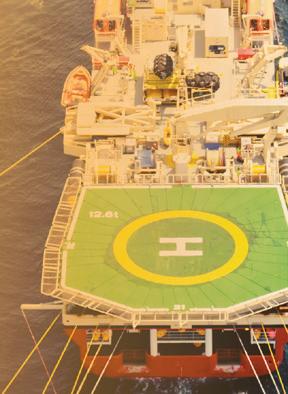
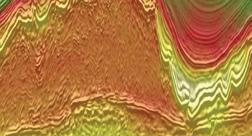

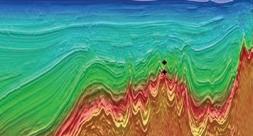

CGG has won a four-year contract extension with Petrobras for its reservoir services centre in Rio de Janeiro, Brazil. Its in-house team of reservoir character ization specialists have worked closely with Petrobras for the last 15 years, supporting its asset teams in optimizing the value of its seismic data and resolv ing complex geophysical challenges present in Brazil’s pre-salt and post-salt fields.
The company will continue to provide its reservoir characterization workflows, such as geostatistical, 4D and azimuthal inversion, while also bringing new technol ogies to further enhance reservoir under standing. These include its EBPetro and EBMatch ensemble-based petrophysical inversion and history matching, machine learning-augmented rock physics work flows, PP-PS inversion and joint azimuthal inversion of amplitudes and velocities.
INDUSTRY NEWS FIRST BREAK I VOLUME 40 AUGUST 2022 25 TGS0822.indd 1 06/07/2022 08:08
Magnus
Global emissions rise but renewable energy increases too, says BP Review of Energy
Global energy demand increased by 5.8% in 2021, exceeding 2019 levels by 1.3%, according to BP’s Statistical Review of World Energy
Between 2019 and 2021, renewable energy increased by more than 8 EJ. Consumption of fossil fuels was broadly unchanged. Fossil fuels accounted for 82% of primary energy use last year, down from 83% in 2019 and 85% five years ago.
Carbon dioxide emissions from ener gy use, industrial processes, flaring and methane (in carbon dioxide equivalent) rose 5.7% in 2021 to 39.0 GtCO2e, with carbon dioxide emissions from energy rising 5.9% to 33.9 GtCO2, close to 2019 levels. Carbon dioxide emissions from flaring and emissions from methane and industrial processes rose more modestly by 2.9% and 4.6% respectively
Oil prices averaged $70.91/bbl in 2021, the second highest level since 2015.
Oil consumption increased by 5.3 million barrels per day (b/d) in 2021 but
(-170,000 b/d) and Angola (-150,000 b/d) reported the biggest declines.
Global natural gas demand grew 5.3% in 2021, recovering above pre-pandemic 2019 levels and crossing the 4 Tcm mark for the first time. Its share in primary energy in 2021 was unchanged from the previous year at 24%.
Coal consumption grew by more than 6% in 2021 to 160 EJ, slightly above 2019 levels and its highest level since 2014. China and India accounted for more than 70% of the growth in coal demand in 2021, increasing by 3.7 and 2.7 EJ, respectively. Global production matched consumption with an increase in supply of 440 Mt. China and India accounted for much of the increase in production, which was largely consumed domesti cally, as well as Indonesia, supporting higher exports. Notably, both Europe and North America showed an increase in coal consumption in 2021 after nearly 10 years of back-to-back declines
about 36% and 40% of the global capacity additions, respectively. Nuclear generation increased by 4.2% – the strongest increase since 2004 – led by China.
Electricity generation increased by 6.2% in 2021. Wind and solar reached a 10.2% share of power generation in 2021, the first time wind and solar power have provided more than 10% of global power and surpassing the contribution of nuclear energy. Coal remained the dominant fuel for power generation in 2021, with its share increasing to 36%, up from 35.1% in 2020. Natural gas in power generation increased by 2.6% in 2021, although its share decreased from 23.7% in 2020 to 22.9% in 2021.
The price of cobalt increased 63% in 2021 to average $51,000/ tonne. Similarly, lithium carbonate prices rose 58% to average $11,000/tonne. So far in 2022, mineral prices have continued to surge. Lithium production rose sharply by 27%, cobalt output was up by only 4%.
remained 3.7 million b/d below 2019 lev els. Regionally, most of the growth took place in the US (1.5 million b/d), China (1.3 million b/d) and the EU (570,000 b/d). Global oil production increased by 1.4 million b/d in 2021, with OPEC+ accounting for more than three-quarters of the increase. Among all countries, Libya (840,000 b/d), Iran (540,000 b/d) and Canada (300,000 b/d) saw the largest increases. Nigeria (-200,000 b/d), the UK
Renewable primary energy (including biofuels but excluding hydro) increased by around 5.1 EJ in 2021 – corresponding to an annual growth rate of 15%, stronger than the previous year’s 9%, and higher than that of any other fuel in 2021. Solar and wind capacity continued to grow rapidly in 2021, increasing by 226 GW, close to the record increase of 236 GW seen in 2020. China remained the main driver of solar and wind capacity growth last year, accounting for
Spencer Dale, chief economist at BP, said: ‘In many ways, this sharp rebound in energy demand is a sign of global success, driven by a rapid recovery in economic activity as the widespread distribution of effective vaccines allowed for an easing in COVID-19 restrictions in many parts of the world and a return to our everyday lives. But it also highlights that the pronounced dip in carbon emissions in 2020 was only temporary: carbon equivalent emissions from energy (including methane), industri al processes, and flaring increased by 5.7% last year. Encouragingly, renewable energy, led by wind and solar power, continued to grow strongly and now accounts for 13% of total power generation. Renewable generation increased by almost 17% in 2021 and accounted for over half of the increase in global power generation over the past two years. The low-carbon energy sources and technologies needed to achieve a fast and deep decarbonization exist today – wind and solar power, biofuels, blue and green hydrogen, CCUS (carbon cap ture, use and storage), and carbon dioxide removals. The challenge is to apply them at unprecedented pace and scale.’

INDUSTRY NEWS 26 FIRST BREAK I VOLUME 40 I AUGUST 2022
Spencer Dale, chief economist at BP.
UK launches first carbon storage licensing round
The UK North Sea Transition Authority (NSTA) has launched the country’s first carbon storage licensing round with 13 areas available.
The new carbon storage areas, along side the six licences which have been issued previously, aim to meet the UK’s
pool and Lincolnshire in the Southern North Sea, Central North Sea, Northern North Sea, and East Irish Sea and are made up of a mixture of saline aquifers and depleted oil and gas field storage opportunities.
This round is envisaged to be the first of many as it is estimated that as many as 100 CO2 stores could be required in order to meet the net zero by 2050 target, said the NSTA which added that it had launched the carbon storage licensing round in response to ‘unprecedented levels of interest from companies eager to enter the market’.
‘The areas on offer have a combination of attributes such as the right geological conditions, proximity to existing infrastruc ture which may be able to be re-purposed, and links to industrial clusters which are looking to carbon storage to help meet their decarbonisation goals,’ said the NSTA.
existing or future offshore wind develop ments – environmental issues and potential overlaps with existing or future petroleum licences.
There are currently six carbon storage licences on the UK Continental Shelf which could meet up to one-fifth of storage needs, if they reach their maximum potential of up to 40 million tonnes per annum (MTPA) injection rates by the mid-2030s.
Deadline for applications is 13 Septem ber and licences are expected to be awarded in early 2023. First injection of CO2 could come as early as four to six years after the licence award, said the NSTA.
target of storing 20-30 million tonnes of carbon dioxide (CO2) in four carbon stor age clusters by 2030.
The areas being offered for licensing are off the coast of Aberdeen, Teesside, Liver
In choosing suitable areas to make available for licensing, the NSTA fully considered issues including co-location with offshore wind – whether there are any known challenges and mitigations around
Andy Samuel, NSTA chief executive, said: ‘Carbon storage is going to be needed across the world. There is growing investor appetite and we are keen to accelerate development of the carbon storage sector so that UK is well positioned to be a global leader.

‘The NSTA is ready to work with industry, government, regulators and others to deliver these exciting projects at pace.’
Maintenance spending on renewables will rival fossil fuels by end of decade, says Rystad
The maintenance, modification and oper ations (MMO) market for the renewable and low-carbon energy industries is set to soar by the end of the decade and approach $250 billion, says Rystad Ener gy.
Its research shows that annual MMO spending, including in oil and gas, will surpass $600 billion in 2030, up from $367 billion in 2019, before the Covid-19 pandemic. Out of that spend ing, the MMO market for renewables and low-carbon energy is set to almost quadruple from $63 billion in 2019 to $244 billion in 2030.
In 2019, 82% of global MMO spending will be related to fossil fuel industries, with 82% of total expenditure originating from the oil and gas industry. By 2030, that total will drop to only 60%.
‘With the rapid adoption of renewa ble and low-carbon energy infrastructure expected by the end of the decade, there will be ample opportunities for MMO players to take advantage. The suppli ers who can adapt quickly and service the maintenance needs of these growing industries will be in pole position to seize a significant portion of this expend iture towards 2030,’ said Ulrik Eriksen, energy services analyst with Rystad Energy.
Combined MMO expenditure in the oil and gas industry is forecast to jump from $303 billion in 2019 to $364 billion in 2030. However, total non-fossil fuel MMO expenditure is projected to surge by 2030. The maintenance market in the solar industry is expected to be worth $64 billion in 2030, up from only $12
billion in 2021. Onshore and offshore wind markets’ spending on MMO will hit a combined $143 billion by the end of the decade, compared to a combined total of $39 billion in 2021.
The CCS industry is expected to spend close to $7 billion on MMO in 2030, up from $1 billion in 2021, while the comparatively small geothermal sec tor will reach $1.6 billion in maintenance expenditure by the turn of the decade.
Regionally, the main driver of global growth will be Asia, including China. MMO spending in the region is expected to grow rapidly from $35 billion in 2021 to $125 billion in 2030, more than half the global market value. Expenditure in North America in 2030 is projected to be $37 billion, while the European market will top $53 billion.
INDUSTRY NEWS FIRST BREAK I VOLUME 40 AUGUST 2022 27
Andy Samuel, NSTA chief executive.
SLB sets out details of 3D survey, offshore Western Australia
Schlumberger Australia has set out its plans to acquire the Bonaparte Multiclient 3D survey in the Bonaparte Basin, off shore Western Australia.
The survey is expected to start as early as September 2022 and will be completed before 30 June 2024. It is estimated that it will take between approx. 120 to 190 days to acquire 12,000 km2
The operational area for the survey is ~200 km north of Port Warrender and Kulumburu, Western Australia, and ~175 km northeast of Ashmore Island and comprises water depths in the order of 20-200 m. The operational area is ~26,000 km2, with approx. 50% of the total area constituting water depths >100 m deep.
The proposed seismic survey will comprise a single seismic vessel towing
up to 12 seismic streamers with 120 m spacing up to 8 km long, at a speed of approx. 4-5 knots (7-9 km/h). The acous tic source will have an effective volume of up to 3000 in3 and will comprise two sub-arrays, with 13 acoustic sources per sub-array (26 in total).
Some 50% of the survey area con stitutes depth to seabed of greater than 100 m. To support effective delivery of the seismic survey, seismic source testing (e.g., bubble tests) will also occur within the acquisition area.
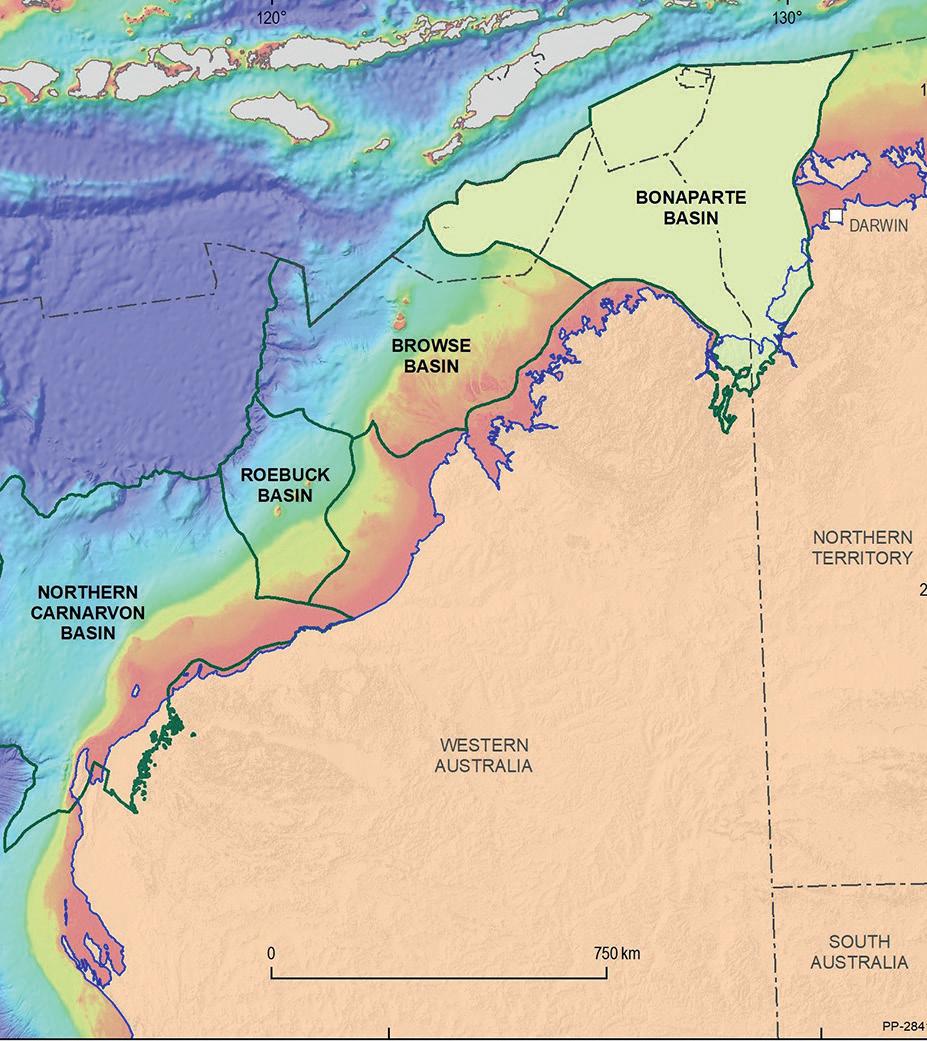
There will be one support vessel and one chase vessel accompanying the seismic vessel. The role of the support vessel and chase vessel is to manage any possible interactions between the seismic vessel, the seismic array (acoustic source
CGG launches cloud solutions business
CGG has launched an HPC & Cloud Solutions business, under the leadership of Agnès Boudot.
Over her 30-year career, Boudot has gained experience in various areas of IT, and specifically HPC, storage & media, and visualization. Before joining CGG, she
led the global HPC, artificial intelligence and quantum business line at Atos, growing this business over the last five years.
Sophie Zurquiyah, CGG CEO, said: ‘The HPC and cloud solutions markets offer CGG significant and immediate business opportunities that capitalize on
our well-established HPC and cloud com puting strengths.’
CGG’s HPC & Cloud Solutions business will be consolidated into the Data, Digital & Energy Transition (DDE) reporting segment under Geoscience (GEO).
ION Geophysical completes reprocessing and reimaging offshore Mauritania
ION Geophysical has completed the reprocessing and reimaging of approx imately 19,100 km² of 3D seismic data offshore Mauritania, West Africa. The multi-client programme was undertaken through an exclusive agreement with the Ministry of Petroleum, Energy and Mines in Mauritania. It is comprised of 11 vintage seismic surveys and provides a seamless, modern, high-resolution data set spanning the Mauritanian offshore coastal basin. This basin is a key part of the frontier MSGBC basin in which
several large-scale, offshore, gas fields have been discovered, with an estimated 63 trillion cubic feet (Tcf) in place in Mauritania thus far.
‘The MSGBC basin has become one that matters in the global oil and gas landscape, even if it is still today a frontier area. We have an enormous potential and we must find the right solutions to use these resources for the development of the country,’ said Chemsdine Sow Deina, exploration director at Societe Mauritani enne des Hydrocarbures (SMH).
Chris Usher, president and CEO if ION Geophysical said: ‘We anticipate additional discoveries will be made that ensure Mauritania’s long-term energy security, as well as exports that fund sustainable economic growth and devel opment.’
The Mauritania 3D reprocessing pro gramme almost triples the amount of 3D data that ION has delivered this year from approximately 10,000 km2 to 29,000 km2 Final pre-stack depth images have been delivered.
INDUSTRY NEWS 28 FIRST BREAK I VOLUME 40 I AUGUST 2022
and streamers), and other vessels, recep tors or activities occurring in the area.
SLB will acquire 12,000 km2 of data offshore West Australia.
Installations and investments in the global offshore wind industry are projected to more than double from $46 billion in 2021 to $102 billion in 2030, Rystad Energy research shows.
Capital expenditure in Europe in 2030 is forecast to approach $53 billion, up from $15 billion last year. The Americas region is projected to spend $3.3 billion this year, up from $700 million last year, and rise further to almost $15 billion by 2030.
China has been a major player in the offshore wind market to date, but the powerhouse’s investments are set to slow as we approach the 2030s. In 2020, China invested almost $25 billion, double what Europe spent in that year, but the country’s total expenditure is forecast to gradually decline to a comparatively small $7.7 billion in 2030.
‘The offshore wind industry is set for substantial growth this decade, with more than 265 gigawatts of operational capacity expected by 2030. As the world moves towards a greener energy mix, invest ments in the offshore wind sector are set to soar and provide ample opportunities
for suppliers to cash in,’ said Anubhav Venkatesh, offshore wind analyst with Rystad Energy.
With more than 26 GW of operational capacity, Europe represents more than 50% of the global total. The continent is expected to have an installed base of more than 57 GW by 2026 when Danish giant Orsted is expected to remain the region’s leading offshore wind developer.
More than 8500 turbines are expected to be operational in Europe by 2026.
Asia, excluding China, and the US, relatively new regions to the offshore wind market, are expected to commission their first large-scale projects in 2022 and 2024. The US is set for a wave of project commissioning towards 2030 as it targets 30 GW of operational offshore wind capacity, although the country is likely to fall short and install only around 21 GW, says Rystad. The Biden-Harris Administration has accelerated lease sales in the US, with eight leases being sold so far this year and the final sale notice for another five released towards the end of May.
TGS reprocesses Central North Sea data
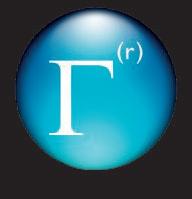

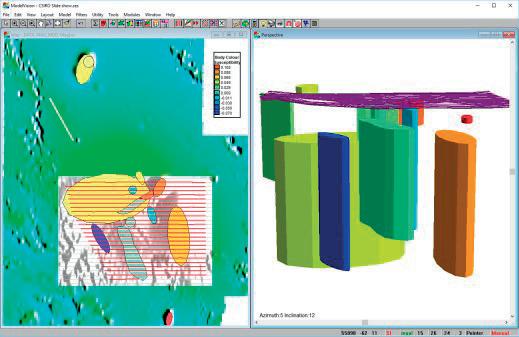
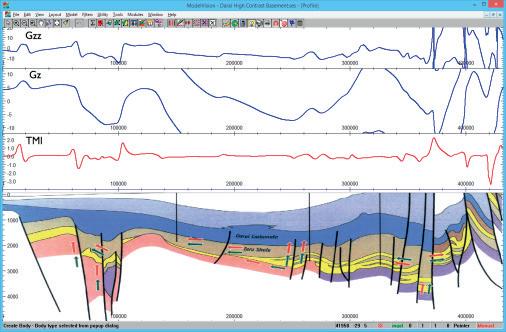
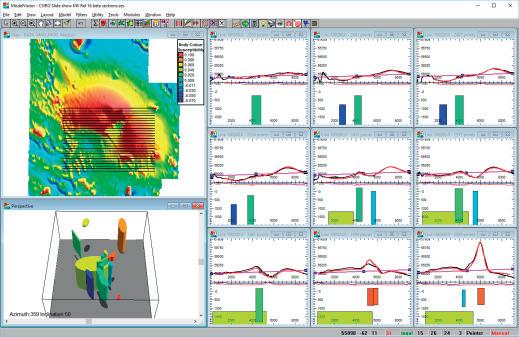
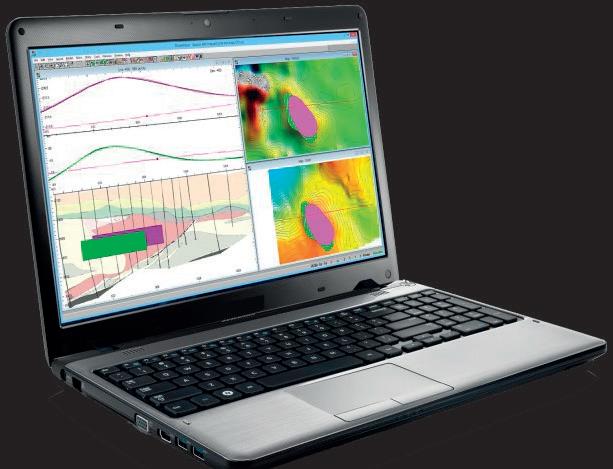
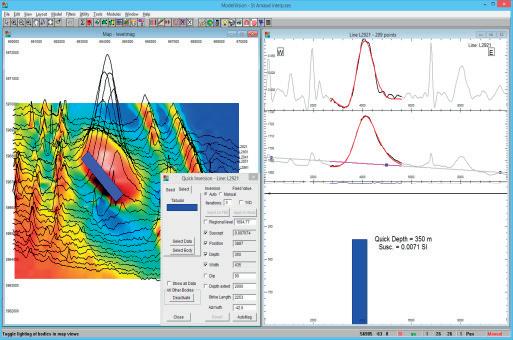

TGS has launched a seismic reprocessing project in the Western Margins of the Central North Sea.
It is reprocessing 3500 km2 of data in the Greater Catcher Area covering quads 21, 28, and 29 of the North Sea on the margins of the UK Central Graben. Acquired in 2011 and 2012, the original data will be reprocessed through a fully comprehensive broadband PSTM pro cessing flow, focused on maintaining the AVO character of the data to allow for an inversion-based quantitative interpretation (QI) workflow to follow.
Highlights of the flow include TGS’ leading inversion-based deghosting
technique, comprehensive shallow water demultiple routines, and a high-fidelity migration algorithm to provide the robust AVO-compliant regional benchmark dataset for the innovative interpretation and inversion workflow.
This data and interpretative QI output, combined with TGS’ existing seismic coverage in the area, will aug ment understanding of the subsurface. This insight will enable the targeting of prolific Tay sandstone reservoirs with a view to future development in an area with excellent prospectivity and infrastructure-led exploration (ILX) opportunities, said TGS.
INDUSTRY NEWS FIRST BREAK I VOLUME 40 AUGUST 2022 29 All sensors Processing 3D modelling 3D inversion Visualisation Analysis Utilities Minerals Petroleum Near Surface Government Contracting Consulting Education ModelVision Magnetic & Gravity Interpretation System Tensor Research support@tensor-research.com.au www.tensor-research.com.au Tensor Research1021.indd 1 03/09/2021 08:18
Wind investments set to double to $100 billion by 2030, says Rystad.
Thirty five wells to be drilled offshore Norway this year, says Westwood

ever, it has delivered more than 1 bnboe of commercial resources at the lowest finding cost, compared to other basins.
The most drilled and best-perform ing play in terms of commercial success and discovered resources was the Middle Jurassic with 1.7 bnboe from 91 wells and a CSR of 36%.
Infrastructure-led exploration (ILX) drilling accounted for 60% of all activity and spend and contributed 2.1 bnboe with a CSR of 35%. The proportion of ILX drilling is expected to trend upwards.
Exploration on the Norwegian Continen tal Shelf will remain buoyant with 35 exploration wells, targeting 2.5 bnboe, expected to be drilled this year according to analysis from Westwood Insight.
However, according to its Norway State of Exploration report, more compa nies are likely to focus on lower-risk ILX drilling to sustain production levels in existing hubs that can provide short cycle opportunities, Westwood said.
The report also shows that 298 explo ration wells were drilled between 2012 and 2021 in Norway with an estimated total exploration spend of $15.4 billion.
Average commercial success rate (CSR) was 24% and the technical suc cess rate (TSR) was 49%. Seventy one commercial discoveries were made with total resources of 3.3 bnboe, at a drilling finding cost of $4.6/boe. There were only six commercial discoveries >100 mmboe, reflecting the decreasing discovery size as the NCS matures.
The Northern North Sea (NNS) was the top performing basin on the NCS in terms of CSR (34%) and discovered volumes (1.1 bnboe). The Barents Sea has continued to disappoint in terms of CSR and the number of discoveries made. How
Shearwater GeoServices wins
4D survey offshore Australia
Shearwater GeoServices has won a con tract from Woodside for 4D baseline sur vey work over gas fields in the Carnarvon Basin Australia.

The survey is expected to take 2-3 months to acquire, and will be conducted by the vessel Geo Coral, equipped with multicomponent sensor streamers. The survey is planned to commence in Q3 2022 and will cover the Scarborough and Jupiter gas fields.
‘The objective of the survey is to provide a modern, robust high-definition survey for development planning, and
ultimately be used as the baseline for time-lapse data in the event of acquisition of future monitoring seismic surveys,’ said Shearwater.
‘This new award by Woodside demon strates continuing commitment to invest in 4D time-lapse for development and reservoir management of their natural gas resources,’ said Irene Waage Basili, CEO of Shearwater. ‘Natural gas is a key low carbon fuel for the future, and high-end seismic surveys are a critical tool for advanced management of these resources.’
There were only 13 discoveries made from HI wells between 2012 and 2021, giving a CSR of just 11%. Total resource discovered was 1.5 bnboe; however, 65% of this was discovered in the early part of the decade in the Barents Sea.
More than 80 companies participated in exploration drilling, 36 of which par ticipated in 10 or more wells. Companies that have been most successful have either been involved in the high impact discover ies of the decade or have targeted the more successful plays such as the Middle Juras sic. ILX-focused exploration portfolios delivered more consistent performance, with higher commercial success rates and lower finding costs but with smaller aver age discovery sizes.
The fields are part of the Greater Scar borough gas fields which are estimated to hold 13.0 TCF (2C, 100%) of dry gas.
INDUSTRY NEWS 30 FIRST BREAK I VOLUME 40 I AUGUST 2022
Some 2.5 bnboe of oil is being targeted in Norwegian waters this year.
Geo Coral will acquire data in the Carnarvon Basin.
TGS extends Northern North Sea OBN survey
TGS has extended the 2021 NOAKA ocean bottom node (OBN) seismic sur vey in the Northern North Sea.
The NOAKA22 survey will comprise an additional 318 km2 of multi-client OBN data within the APA area between Oseberg and Alvheim in the Norwegian North Sea.
‘The NOAKA fields are one of the largest developments on the NCS, with
recoverable reserves of more than 500 million barrels of oil equivalents. The area has witnessed significant infrastruc ture-led exploration in recent years, and further prospectivity is anticipated,’ said TGS.
This latest OBN survey is the third to be acquired by TGS in the North Sea in recent years after the initial phase of
NOAKA21 and the flagship Utsira OBN project, a joint survey with AGS.
TGS will use of ultra-long offset sig nal for FWI-based model-building, and full-azimuth, high-fold, high signal-tonoise ratios, reliable AVO, and ultra-long offsets to illuminate the complex geology for field development and near-field exploration.
CGG wins OBN contract in Nile Delta
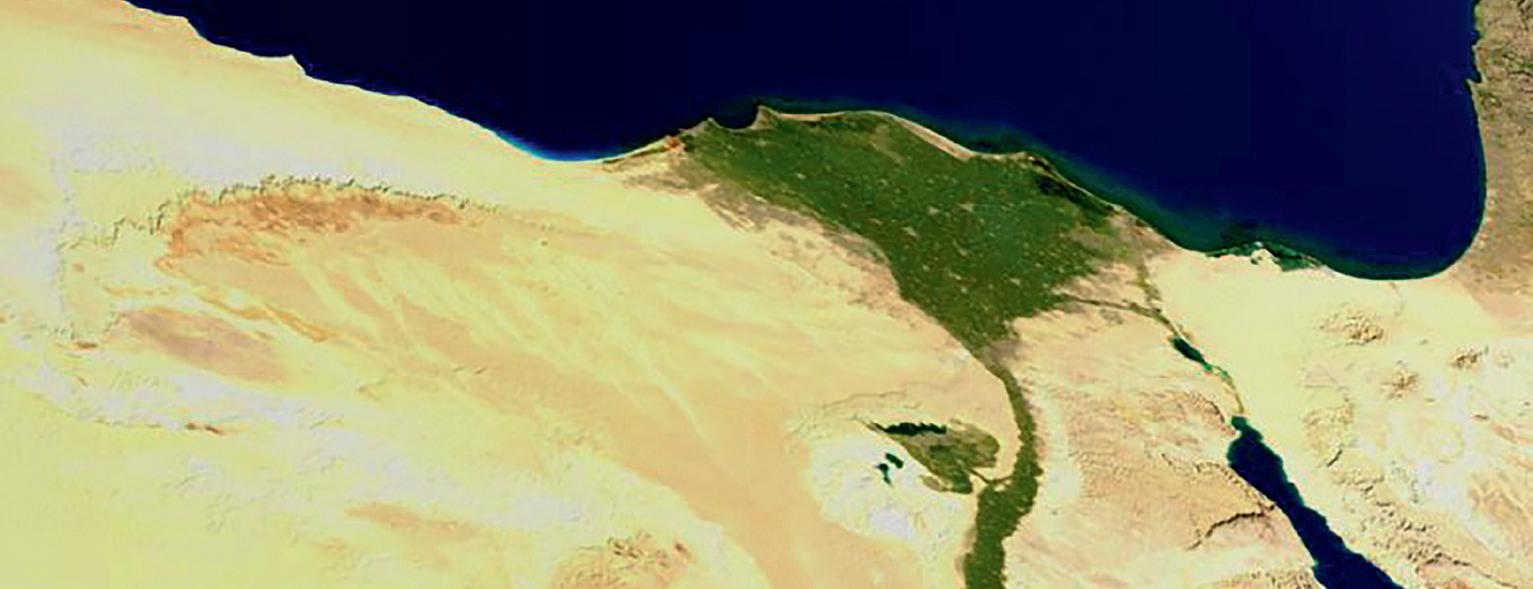
CGG has won a project from bp and JV partner Pharaonic Petroleum Co for the 3D seismic imaging of the first OBN survey ever conducted in the Nile delta covering the Atoll and Atoll North fields.
CGG will apply its OBS & FWI imaging technologies, expertise and specialised HPC from its UK and Cairo imaging centres to deliver the 3D seismic images of pre-Messinian targets with greater velocity model detail, image bandwidth and AVO reliability for improved field development planning and near-field exploration.
Peter Whiting, EVP, Geoscience, CGG, said: ‘This new 3D OBN imaging project is the first of its kind in the Nile delta.’
Energy transition briefs
Shell has taken the final investment decision to build Holland Hydrogen I in Rotterdam, which will be Europe’s largest renewable hydrogen plant once operational in 2025. The 200MW elec trolyser will produce up to 60,000 kilo grams of renewable hydrogen per day.
Neptune Energy has joined the Aiming for Zero Methane Emissions Initiative, a project to cut emissions of the greenhouse gas to near zero by 2030. Signatories to the initiative, which is developed by the Oil and Gas Climate Initiative (OGCI), aim to reach near zero methane emissions from their operated assets by the end of this decade.
The state government of North Rhine-Westphalia is funding a €770,000
feasibility study on a 100-megawatt water electrolysis plant for the produc tion of green hydrogen at the Ineos site in Köln/Dormagen. The project could lead to a reduction in greenhouse gas emissions of more than 100,000 tonnes per year.
Fluxys and Equinor have agreed to transport captured CO2 from emitters to safe storage sites in the North Sea, connecting Belgium to Norway. The project includes a 1000 km CO2 export trunkline operated by Equinor which will transport CO2 for permanent stor age under the seabed on the Norwegian Continental Shelf. A final investment decision is expected in 2025.
Petronas has signed an agreement with Mitsui & Co. to evaluate poten
tial CO2 storage sites offshore pen insular Malaysia. The collaboration also covers a capturing and gathering strategy of CO2 from various indus tries, competitive transportation of the CO2 and emerging technology in direct air capture.
ExxonMobil, Shell, CNOOC, and Guangdong Provincial Develop ment and Reform Commission have signed an agreement to evaluate a potential carbon capture and storage project at the Dayawan Petrochemical Industrial Park in Huizhou, Guang dong Province, China. The project has the potential to capture up to 10 million metric tonnes of CO2 a year from Dayawan’s industrial sector.
INDUSTRY NEWS FIRST BREAK I VOLUME 40 AUGUST 2022 31
Shell advertises for TikTok expert
Shell has made a bid to communicate its energy transition credentials to a younger audience by advertising for a full-time TikTok channel manager to drive a strate gy for the company on the popular social media platform.
PGS expands Côte d’Ivoire dataset
PGS has expanded its Côte d’Ivoire mega survey to bring total coverage to 33,861 km2 of 3D data and 31,743 line km of 2D data.
Open acreage in the prospective Tano Basin is targeted with this addi tional 3108 km2 of 3D seismic data. This expands continuous mega survey data coverage from Côte d’Ivoire to Nigeria.
In partnership with PetroCi and Direction Générale des Hydrocarbures, PGS has worked to ensure that the various 3D input datasets have been matched, merged and re-binned onto a common grid resulting in a single, con tinuous volume of full-stack seismic data in the time domain.
The mega survey spans the west ern extension of the prolific Tano Basin and covers the high-profile Baleine-1X (Eni) discovery with pre liminary resource estimates of up to 2 billion barrels of oil in place and
up to 2.4 trillion cubic feet (TCF) of associated gas in two main Creta ceous reservoir levels. The dataset also occurs along-strike of the 2021 Eni ‘Eban-1X’ discovery, offshore Ghana, which is reported to have found light oil in an 80m-thick section of Ceno manian sandstones. These discoveries highlight the significant remaining potential of Cretaceous shelf edge play along the margin.
‘MegaSurvey regional seismic data enables exploration for analogs, the identification of new prospects, and allows detailed play analysis from shelf to deep water, along the entire margin,’ said PGS in a statement. ‘Five key regional horizons have been tied to well and interpreted to allow field-scale geological understanding to be placed into a basin-wide context and open acreage opportunities to be assessed with confidence.’
The role is for a ‘TikTok platform expert able to drive the ambition to cat apult Shell to be one the best content creators on TikTok’, according to a job brief posted by the company.

The successful candidate will ‘start a new chapter that will help the energy engaged audience and Gen Z worldwide understand in an engaging way the oppor tunities of energy transition and the Shell role and ambition in it’, the company’s brief outlined.
TikTok, which is operated by the Chinese company ByteDance, is a popular destination for short-form mobile video.
Shell will aim to use TikTok to outline progress recently published in its Energy Transition Progress Report 2021, which included critical investment decisions in the production of low-carbon fuels, solar and wind power, hydrogen and significant changes to Shell’s upstream and refinery portfolios.
‘As we accelerate towards our goal of becoming a net zero emissions business, we are putting greater emphasis on how we engage with all stakeholders on the many complex issues and opportunities related to the energy transition,’ said Shell CEO Ben van Beurden.
Wind energy projects will create 100,000 jobs in the UK, says report
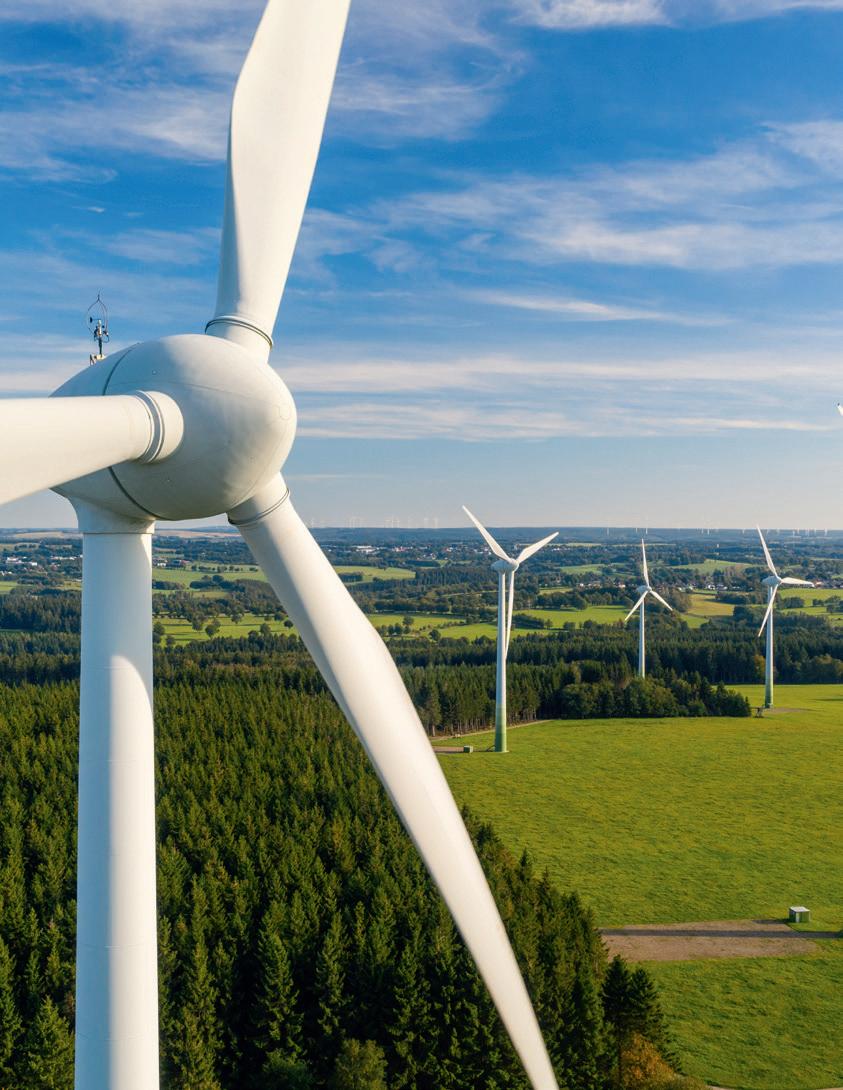
The Offshore Wind Skills Intelligence Report has outlined that the sector will employ in the region of 100,000 people in the UK by 2030.
The report, published by the East of England Energy Group of 200 organisations, also indicates that between 2022 and 2030 the indus try in the UK will see a benefit of $190 billion from private investment in new offshore wind projects. This will take the average annual spend to more than $20.8 billion, significantly higher than last year’s reported private investment which showed an average spend of just over $12.2 billion per year.
Investments are expected from major developers including Scottish Power Renewables, Vattenfall, RWE, and Equinor.
INDUSTRY NEWS 32 FIRST BREAK I VOLUME 40 I AUGUST 2022
nikkimeel - stock.adobe.com.
PGS expects much-improved second quarter revenue

BRIEFS
PGS expects to report Q2 2022 income of approx. $274 million, compared to $185.9 million in Q2 2021.
Contract revenues ended at approx. $63 million in Q2 2022, compared to $51.5 million in Q2 2021. Multi-client late sales revenues were approx. $108 million in Q2 2022, compared to $65.5 million in Q2 2021. Multi-client pre-funding rev enues were approx. $96 million in Q2 2022, compared to $62.7 million in Q2 2021, and Multi-client cash investment ended at approx. $26 million, compared to $25.7 million in Q2 2021.
Cash and cash equivalents at June 30, 2022 are estimated to approx. $220 million, compared to $155.4 million at June 30, 2021 and $163.9 million at March 31, 2022. Most of the company’s multi-client late sales in Q2 2022 will be collected in Q3 2022 and are expected to contribute to strong cash flow in the quarter.
The order book at June 30, 2022 is $360 million, compared to $315 million at March 31, 2022 and $410 million at June 30, 2021.
‘We continue to see an improving marine seismic market and we deliver the second highest quarterly revenue number since Q4 2014. Significant lates sales, including high transfer fees, is a con firmation that our multi-client library is highly attractive to customers and that investments in exploration seismic is again increasing. During Q2, all our six active 3D vessels came back in operation. The contract acquisition market continued to improve in the quarter and dominated our vessel activity. However, contract revenues are impacted by steaming and standby early in the quarter, and by mobilization on two surveys where production and revenue impact primarily will be in Q3 and Q4. Our fleet is fully booked through Q3, and the winter season is already firming up with activity and pricing continuing on a positive trend,’ said president and CEO Rune Olav Pedersen.
Cash and cash equivalents in excess of $200 million at quarter-end will have to be used to repay upcoming amortizations of the TLB and ECF loans. The company has received the gross proceeds of approxi mately $85 million from the equity private placement in Q2, 2022, while proceeds from the subsequent equity offering and proceeds from drawing the new $50 million senior secured debt is expected in Q3 2022.
PGS issued a prospectus on June 29, 2022 and commenced a subsequent offer ing of up to 38,155,803 new shares. The subscription period closed on July 15, 2022.
inApril announces sales of OBN equipment and QC software
inApril has sold an ocean bottom nodal sys tem based on the A3000 node to a European research institution. Meanwhile, Profocus Systems, an inApril company, has started on the delivery of a data management system for a new customer developing a proprietary ocean bottom node system.
Finally, inApril’s QC software Argus SourceQC is now operating on seven source vessels and has recently been sold to an eighth. Argus SourceQC is
a real-time, non-intrusive QC software that warns the operator of anomalies or changes in hydrophone air gun signatures. It was developed for observers and gun mechanics with the aim of quickly detect ing air leaks, electrical leakage, drop outs, auto-fires, misfires and loose hardware. The latest version is a Beta release of the SourceQC Autopilot, including automatic data QC and alarm notification with no need for manual monitoring.
Sercel has successfully bid for ION Geo physical Corporation’s software business. The assets were put up for sale after ION announced US chapter 11 bankruptcy in April. The company intends to retain all employees within the business. The acquisition is expected to close in the third or fourth quarter of 2022.
The deadline for oil and gas companies to submit bids for the Lebanon Second Licensing Round has been extended to 15 December 2022. Eight blocks are on offer with a simplified bidding process to attract new investors.
EMGS has secured $3.8 million in revenue related to uplifts from its mul ti-client library in Norway. The company has also recorded $1.4 million in late sales and $1.2 million in revenue from a change of control event, also related to its existing multi-client library in Norway.
Magseis Fairfield has won an OBN project in the Gulf of Mexico from a repeat cus tomer, with an option for a programme extension. The initial survey will use Magseis Fairfield’s ZXPLR technology and is expected to take three months. Magseis Fairfield has won a one-month extension to an OBN survey in the North Sea that will take three months.
Green Energy Group (formerly SeaBird) has announced that an agreed sale of its seismic data acquisition business has been put on hold. Agreement in principle on the transaction had been reached but has stalled ‘due to events outside of both parties control’. The period of exclusivity has lapsed and the company has restart ed negotiations with other suitors.
ExxonMobil has entered into an agree ment with Whitecap Resources Inc. for the sale of XTO Energy Canada, jointly owned by Imperial and ExxonMobil Can ada, for $1.47 billion. The assets include 567,000 net acres in the Montney shale, 72,000 net acres in the Duvernay shale and additional acreage in other areas of Alberta.
INDUSTRY NEWS FIRST BREAK I VOLUME 40 AUGUST 2022 33
Rune Olav Pedersen, president and CEO of PGS.
Offshore wind expansion will outperform targets
The offshore wind industry enjoyed its best-ever year in 2021, with 21.1 GW of new capacity connected to the grid, according to the latest Global Offshore Wind Report launched by the Global Wind Energy Council (GWEC).
GWEC has revised up its outlook for 2030 to 45.3 GW, or 16.7% from last year’s report and believes that 260 GW of new offshore wind capacity could be added in 2022-2030, bringing total global offshore wind installations to 316 GW by the end of this decade.
The energy crisis and the Russian invasion of Ukraine have led to govern ments further raising their offshore wind targets as they look to secure their energy supplies, said GWEC. The report forecasts government targets will take the world to around 370 GW of capacity by 2031, close to the GWEC/IRENA Offshore Wind Energy Compact’s target of 380 GW of offshore wind installations by 2030.
‘On one hand, we see political ambitions increase exponentially. But on the other hand, the industry is facing increasing costs and disrupted supply chains, jeopardizing its long-term ability to realize these targets,’ Ulrik Stridbæk, vice-president and head of regulatory affairs at Ørsted, said.
There was a three-fold increase in grid connection worldwide from 2020 to
2021, with 21.1 GW of new installations bringing global capacity to 56 GW. Yearon-year growth of 58% means offshore wind now represents 7% of total global cumulative installations.
China contributed 80% of new off shore installations last year, which makes 2021 the fourth year the country has led the world in new installations. Vietnam’s proactive approach delivered further capacity, and GWEC forecasts that by the end of 2022 Asia will replace Europe as the world’s largest offshore market. The report suggests it could take until 2031 for Europe to regain the crown.
In 2021 57 MW of floating offshore wind projects were installed bringing the global total to 121.4 MW. Of those new installations, 48 MW were in the UK, 5.5 MW in China, and 3.6 MW in Norway.
The report predicts that by 2031 315 GW of new offshore wind capacity will be added. As the volume of annual offshore wind installations is expected to more than double from 21.1 GW in 2021 to 54.9 GW in 2031, offshore’s share of new global wind installations is set to grow from 23% in 2021 to at least 30% by 2031.
Considering the increased floating wind target in the UK and the accelerated floating project development activities in Europe, Asia, and North America, which bring the current global floating project pipeline to
120 GW,
by 14% from last year’s
and predicts that 18.9 GW is likely to be built globally by 2030, of which 11 GW will be in Europe, 5.5 GW, in Asia and the rest in North America.
Also, GWEC has identified more than 700 GW of offshore wind projects that are at different stages of development world wide, of which 120 GW is floating wind.
Currently, offshore wind projects totalling 23 GW capacity are under con struction. With a 49.5% market share, Europe is now taking the lead in offshore wind project construction, followed by Asia (46.4%) and the US (4.1%).
China is the most active market with 7.8 GW under construction, followed by the UK (5.6 GW), Netherlands (2.3 GW), Taiwan (2.1 GW), France (1.4 GW), and Germany (1.1 GW).
Getech subsurface software supports UK carbon licensing round
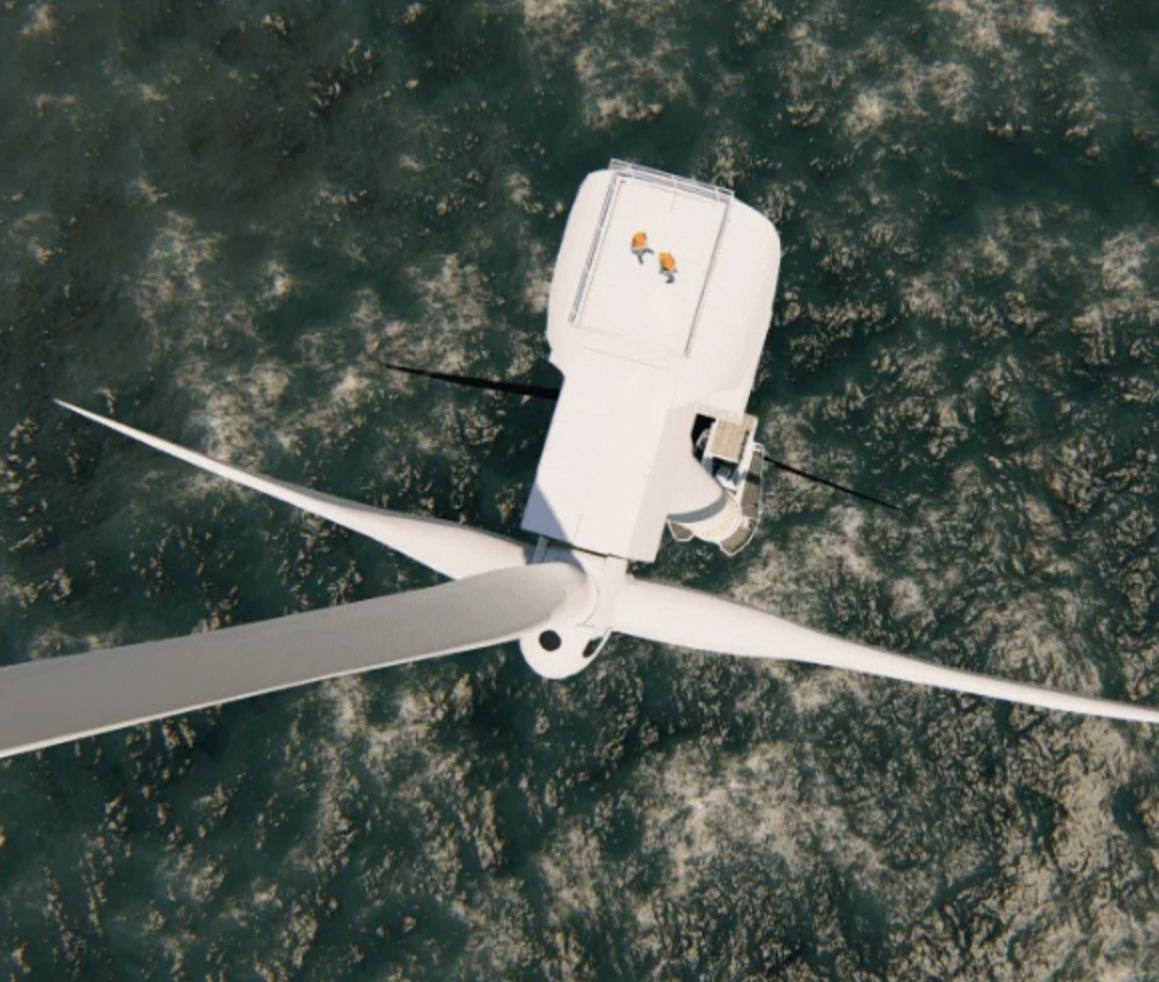
Getech has won a contract to deploy its proprietary geospatial software and subsurface expertise to support the UK’s first carbon storage licensing round.
Working with the North Sea Tran sition Authority (NSTA), Getech has used its Exploration Analyst software to leverage NSTA’s in-house data to create strategic maps that the NSTA is using to define optimal areas for CO2 storage.
The NSTA is inviting bids on 13 high graded areas.
Getech’s chief executive officer, Dr Jonathan Copus, said: ‘NSTA’s use of Exploration Analyst to map and pro mote an integrated ‘emissions-to-storage’ value chain in and around the UK North Sea showcases another exciting applica tion of products that we originally devel oped for petroleum customers, and which we are now establishing as essential tools
in geothermal energy, critical minerals, carbon storage and green hydrogen.’
Some 130 commercial-scale CO2 cap ture projects were announced in 2021, and the International Energy Agency (IEA) is forecasting that capital spending on CCUS could exceed $40 billion by 2024 (from $1.8 billion in 2021). A further 700 carbon storage projects must be identified by 2030 to stay on track for the IEA’s 2050 Net Zero Emission Scenario.
INDUSTRY NEWS 34 FIRST BREAK I VOLUME 40 I AUGUST 2022
GWEC has upgraded its 2030 global floating wind forecast
report
Oil and Gas Round-up
Wintershall Dea has been given con sent to start production from the Nova field in the North Sea. Nova will be developed with two seabed templates, one for oil production and one for water injection (to increase oil recovery). The field will be tied back to the Gjoa field for processing and export. Reserves are estimated at about 14 million standard cubic metres of oil equivalent (90 mil lion bbls o.e.).
Strike Energy has confirmed an extension of high-quality conventional gas within the Kingia Sandstones at WE3 at the West Erregulla gas field in the Perth Basin, Western Australia. The Kingia Sandstone reservoir was encountered between 4731 m MD and 4791 m MD with a gross gas column of 60 m. Mud logs, logging while drilling and wireline logging tools were used to evaluate the Kingia Sandstone. The Kingia is made up of a single package of high-quality reservoir totalling 38 m of net pay with an average porosity of 13.8% and up to 19%. The sands within this section are observed to be con
sistent with other Kingia penetrations for the field and across the broader play. Strike said that the WE3 reservoir characteristics are the best observed in the field to date.
Equinor has agreed to sell to Shell 51% of its interest in the North Platte deep water development project in the US Gulf of Mexico. Equinor will retain 49% interest in the project, and Shell will become the new operator of the field. Renamed Sparta, it straddles four blocks of the Garden Banks area, 275 km off the coast of Louisiana in approx. 1300 m of water depth.
Trinity Exploration and Production has announced that drilling oper ations have commenced for the first well of its 2022 six well programme in Trinidad and Tobago, targeting an aggregate 450-1100mbbls of reserves. A 3D seismic survey in 2020 identified a ‘hopper’ of c.40 infill opportunities, which includes c.35 conventional wells and c.5 high angle/horizontal wells.
Serinus Energy ’s two-well exploration programme in Roma
Searcher adds Indonesia to its subsurface database
Searcher Seismic has formed a part nership with the Indonesian Petroleum Association (IPA) on the use of Geo Clerk, Searcher’s subsurface geo-im agery search engine. GeoClerk enables geoscientists and engineers to discover geological information from a range of data libraries and technical archives.
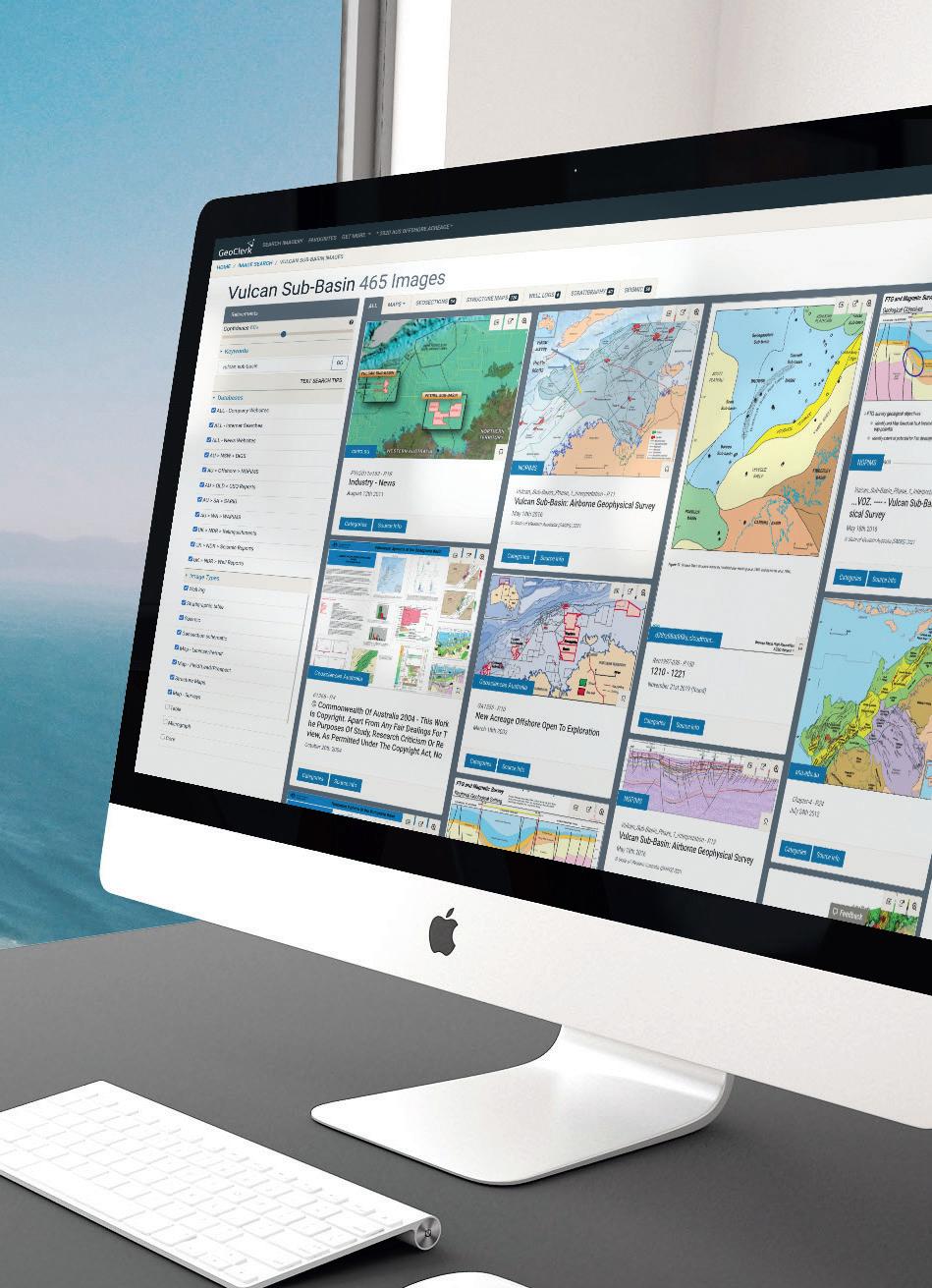
The IPA was founded 50 years ago and holds an annual convention to address the need for and market the development of the upstream oil and gas industry in Indonesia.
The IPA convention proceedings, technical symposiums and other spe cial publications across Indonesia and its basins, comprising more than 4700 documents and dating back to 1972, will now be accessible through GeoClerk.
‘We are looking forward to working together with the IPA and providing our GeoClerk users with an exploration search engine to discover subsurface information across our growing library of data sources. This saves GeoClerk users substantial amounts of research time and ensures they find information relevant to their search criteria,’ said VP of Operations for Searcher, Alan Hopping.
‘The IPA is keen to make its pub lications available to a wider global audience and sees this partnership as a way of achieving that aim. These pub lications provide an invaluable resource on the geology of Indonesia and oil and gas exploration and production in the country,’ added the IPA.
nia continues to progress towards commencement of drilling. Drilling of the Canar-1 well is expected to commence on schedule in mid-July, and once drilling is completed, the rig will move to the Moftinu Nord-1 location and start drilling. Canar-1 well is located 4 km to the west of the Moftinu gas plant, while the Moftinu Nord-1 well is located 5.2 km to the northwest of the Moftinu gas plant. Production from each well will be connected to the Moftinu gas plant, utilizing current excess plant capacity.
Equinor has drilled wildcat well 34/9-1 about 35 km northeast of the Kvitebjørn field in the North Sea and 167 km northwest of Bergen. The objective of the well was to prove petroleum in Lower Cretaceous res ervoir rocks (the Sola Formation in the Cromer Knoll Group). The well encountered the Sola Formation, but reservoir rocks in the form of sandstone were not present. Data acquisition was carried out.
INDUSTRY NEWS FIRST BREAK I VOLUME 40 AUGUST 2022 35
Searcher Seismic has partnered up with Indonesian Petroleum Association on the use of its GeoClerk search engine.
Near Surface Geoscience ranges from ground penetrating radar techniques to time lapse ERT seismic micronzonation and modelling algorithms. The field covers mining, ground engineering and water seepage analysis and other sectors. These papers will be presented at the EAGE’s Near Surface Mining Event.

Michael Becken et al demonstrate the use of an optically pumped magnetometer (OPM) suspended below an UAV to measure scalar EM responses.
Jesper Emilsson et al will discuss the effects an airborne antenna solution has on antenna footprint, unwanted signal input and signal loss. They also describe a few scenarios where airborne GPR has been successfully used.
T.-J. Hupe et al demonstrate that PSI can be used to produce virtual-source underground seismic surveys resembling an active-source seismic survey.
Hector R. Hinojosa presents the results of an ERI survey that deployed eight electrical resistivity profiles and four continuous flight hollow-stem auger cores.
Julien Oukili et al demonstrate what abundant 3D exploration seismic data coverage could offer in the search of net zero energy solutions.
Kevin Jarvis demonstrates why subsurface characterisation, providing a clear and detailed image of the distribrution of lithologies, is best achieved through joint inversion of both lithologies and elastic properties.
Sasha Ziramov et al show how the mineral sector could deliver an order of magnitude saving, while substantially increasing the data density and hence allowing optimum performance of modern seismic imaging algorithms.
Shohreh Hassanpour et al investigate the utility of magnetic data to understand the distribution of concentrating on porphyry systems in NW Iran.
Submit an article
First Break Special Topics are covered by a mix of original articles dealing with case studies and the latest technology. Contributions to a Special Topic in First Break can be sent directly to the editorial office (firstbreak@eage.org). Submissions will be considered for publication by the editor.
It is also possible to submit a Technical Article to First Break. Technical Articles are subject to a peer review process and should be submitted via EAGE’s ScholarOne website: http://mc.manuscriptcentral.com/fb
You can find the First Break author guidelines online at www.firstbreak.org/guidelines.
during the course of the year.
Special Topic
MINING
NEAR SURFACE GEO &
36 FIRST BREAK I VOLUME 40 I AUGUST 2022 Special Topic overview January Land Seismic February Digitalization / Machine Learning March Reservoir Monitoring April Unconventionals and Passive Seismic May Global Exploration Hotspots June Leading Geosciences in a New Era July Modelling / Interpretation August Near Surface Geo & Mining September Reservoir Engineering & Geoscience October Energy Transition November Marine Acquisition December Data Management and Processing More Special Topics
may be added

CALENDAR EAGE Events Non-EAGE Events 98 FIRST BREAK I VOLUME 40 I AUGUST 2022
OF EVENTS August 2022 22-24 Aug Third EAGE Marine Acquisition Workshop www.eage.org Oslo Norway 23-25 Aug EAGE Asia Pacific Workshop on CO2 Geological Storage www.eage.org Perth Australia September 2022 5-7 Sep ECMOR 2022 European Conference on the Mathematics of Geological Reservoirs www.ecmor.org The Hague and online Netherlands 7-8 Sep Second EAGE Workshop on Advanced Seismic Solutions in the Gulf of Mexico www.eage.org Ciudad de Mexico and online Mexico 12-14 Sep MEDiNA Technical Conference and Exhibition medinace.aapg.org Tunis Tunisia 13-15 Sep EAGE Conference on Digital Innovation for a Sustainable Future www.eage.org Bangkok Thailand 14-16 Sep Fourth HGS/EAGE Conference on Latin America www.eage.org Cartagena Colombia 18-22 Sep Near Surface Geoscience Conference & Exhibition 2022 www.nsg2022.org Belgrade Serbia 19-21 Sep Sixth EAGE High Performance Computing Workshop www.eage.org Milan Italy 26-28 Sep Sixth International Conference on Fault and Top Seals faultandtopseals.org Vienna Austria 27-28 Sep EAGE Workshop on Innovative Reservoir Modeling into Digital Proliferation www.eage.org Kuala Lumpur Malaysia October 2022 4-6 Oct IX Simpósio Brasileiro de Geofísica Curitiba Brazil 10-12 Oct Sixth EAGE Eastern Africa Petroleum Geoscience Forum The future of petroleum geoscience in the Eastern African energy mix www.eage.org Cape Town and online South Africa 12-14 Oct First EAGE Western Africa Exploration & Production Workshop Collaboration in frontier and emerging exploration in Western Africa www.eage.org Cape Town and online South Africa 12-14 Oct Second EAGE Workshop on EOR in Latin America www.eage.org Bogotá Colombia Near Surface Geoscience Conference & Exhibition 2022 18-22 SEPTEMBER Belgrade, Serbia www.nsg2022.org
CALENDAR
CALENDAR EAGE Events Non-EAGE Events FIRST BREAK I VOLUME 40 AUGUST 2022 99 14-16 Oct Baku 2022 Fourth international conference on Geology of the Caspian Sea and Adjacent Areas www.eage.org Baku Azerbaijan 24-27 Oct 5 th Asia Pacific Meeting on Near Surface Geoscience & Engineering www.eage.org Taipei Taiwan 26-28 Oct First EAGE Guyana-Suriname Basin Conference Discoveries and Opportunities to Harness the Potential of a New Oil Patch www.eage.org Georgetown and online Guyana 28-31 Oct Second EAGE Subsurface Intelligence Workshop www.eage.org Manama Bahrain November 2022 3-4 Nov Second EAGE Conference on Near Surface & Mineral Exploration in Latin America www.eage.org Bogota Colombia 7-9 Nov EAGE GET 2022 3 rd EAGE Global Energy Transition Conference & Exhibition www.eageget.org The Hague and online Netherlands 14-15 Nov Second EAGE Workshop on East Canada Offshore Exploration www.eage.org St John’s and online Canada 15-17 Nov Sixth EAGE Rock Physics Workshop Impacts & Trends of the Digital Transformation www.eage.org Riyadh Saudi Arabia 21-22 Nov First EAGE/SBGf Workshop on Reservoir Monitoring and its Role in the Energy Transition www.eage.org Rio de Janeiro and online Brazil 23-25 Nov Third EAGE Conference on Pre Salt Reservoirs www.eage.org Rio de Janeiro and online Brazil 28-29 Nov Asia Petroleum Geoscience Conference & Exhibition (APGCE) www.eage.org Kuala Lumpur Malaysia 28-30 Nov Eighth EAGE Arabian Plate Core Workshop: From Play Concepts to Reservoir Heterogeneity www.eage.org Dhahran Saudi Arabia December 2022 1-2 Dec Fourth EAGE Workshop on Unconventional Resources www.eage.org Bogota Colombia 5-7 Dec 2 nd EAGE Workshop on Fiber Optic Sensing for Energy Applications in Asia Pacific www.eage.org Kuala Lumpur Malaysia 6-8 Dec 2 nd EAGE/SEG Workshop on Geophysical Aspects of Smart Cities www.eage.org Hong Kong China 6-8 Dec Second EAGE Conference on Renewable Energy in the Middle East and Africa www.eage.org Muscat Oman February 2023 15-17 Feb Fifth EAGE Naturally Fractured Reservoirs Workshop www.eage.org Aix-en-Provence France 21-23 Feb 2 nd AAPG/EAGE Papua New Guinea Petroleum Conference & Exhibition www.eage.org Port Moresby Papua New Guinea March 2023 1-3 Mar International Petroleum Technology Conference (IPTC) 2023 2023.iptcnet.org Bangkok Thailand 7-9 Mar Middle East Oil, Gas and Geosciences Show 2023 www.meos-expo.com Sanabis Bahrain May 2023 16-18 May Energy Geoscience Conference 2023 https://www.energygeoscienceconf.org/ Aberdeen United Kingdom June 2023 5-8 Jun 84th EAGE Annual Conference & Exhibition www.eageannual.org Vienna Austria















































































































 Nysveen, Rystad Energy’s head of analysis.
Nysveen, Rystad Energy’s head of analysis.














































